#Spanish Chestnut Pork
Text
Astons Specialities brought back the Spanish Chestnut Pork (S$18.90+) with one dollar price difference. This chestnut fed pigs from the autonomous region of northwestern Spain is flavourful and so succulent juicy. Along with the price increase, they also stopped the apple sauce pairing and replaced with a generic brown sauce. :( Picked potato wedges and creamy coleslaw for my two sides to accompany the main course.


Topmost image courtesy of Astons Specialities.
#Astons Specialities#Sembawang Shopping Centre#Western#Spanish Chestnut Pork#Pork Chop#Galician Meat#Spain#Flavourful#Succulent#Juicy#Charred#Potato Wedges#Coleslaw#Brown Sauce#Restaurant#Dinner#Food#Buffetlicious
21 notes
·
View notes
Text
P FKN R Intro
I'm at work, sort of working, sort of tinkering with some writing stuff at lunch, especially the beginning of P FKN R in hopes that I might manufacture some inspiration. Too soon to tell, but maybe if I share it here that will spur me on some more. Here we go!
___
Jamaica Plain’s cars were jammed onto its narrow streets, effectuating a one-way rule by default; those that did crawl through broadcasted an amalgam of sounds into the Latin Quarter: Spanish talk radio, classic rock, and of course, full and knocking reggaetón beats.
Jamaica Plain’s three-story homes groaned as they expanded at high noon, stacked and running from one end of Chestnut Avenue to the other, one of those narrow streets in the time-honored New England style. In another facet of that tradition, its air rippled in a summer scorcher, wafting smells over from La Isla café on the corner: the strong oil-sweet of fried plantains and roasted pork, the kind Jane Rizzoli liked to order with a side of rice when she sat down at one of their vinyl-topped, worn-in, peach-colored tables.
JP pulsated at lunch time.
Jane’s stomach gurgled when she remembered her last meal: a chugged cup of coffee at the marble counter in the Beacon Hill home of the woman kneeling over the body they’d been called to investigate. The image of it was made more grotesque by the contrast of her Aeron skirt and Bottega Veneta heels with the contorted limbs of the man on the walkup in broad daylight.
Jane still liked it, Maura Isles’ high-class wardrobe and the attitude it brought to neighborhoods like this, neighborhoods like her own. That attitude, the I’m the hottest in the room chest-beating, shoulder-brushing mindset, matched what Jane always knew about Boston’s real cultural pockets. The ones with subsidized housing and community gardens and spots like La Isla. “Watcha got for me?” Jane said by way of greeting.
Maura looked up, her long, highlighted hair swishing to the other shoulder when she shook it out. Her green eyes shimmered and she smirked when Jane winked. “It’s nice to see you, too.”
“Saw ya like thirty minutes ago,” said Jane. “And if we hurry this up, cut the pleasantries, I can take you right on over to that restaurant and introduce you to the best lunch you’ll ever eat in JP.” She pointed to the wide-open window view of the restaurant just a football field away.
“Hmm,” Maura replied, “I could be persuaded, I suppose. Penetrating wounds to the chest and abdomen, surrounding shell casings would indicate he was shot.”
Jane pursed her lips and smiled at the same time. She crossed her nitrile-gloved hands over her hips and shrugged under her blazer for some relief from the beads of sweat rolling down her back. She should not have worn black in late June. “You don’t say,” she teased. But then, quickly back to business, she pointed to the decedent’s broken ankle, distorted and impossibly angled toward midline. “That from this fall?” She asked.
Maura stood, narrowed her brows at Jane’s narrowed brow. “Can’t say right now,” she answered. “But these steps are narrow and uneven. It’s possible.”
“Even if it isn’t, he wa’n’t goin’ very far,” Jane commented. She clenched her jaw, and her masseter muscle clicked in investigatory concentration. “What’s on his hand?”
“Burns,” Maura said. They shared a look, one that only experience, only dozens and dozens of murders, could engender. A car door slammed and footsteps approached as they communicated about the man on the ground without words.
Maura never went to JP unless there was work to be done, and Jane? Jane really only traveled out this way for murder anymore, which was a damn shame because the food was good, and so was the company - even if that company happened to be related to the asshole walking up to them now. “Hey oh - the hell are you doin’ at my crime scene?” barked Jane.
Rafael Martinez, lieutenant of the Drug Control Unit.
Tall, dark-skinned, in a baby blue v-neck stretched against his defined chest, with a Boricua jawline that showcased his trimmed beard like art. He ran his hand over his shaved head once, and licked his lips on his way to the woman shouting at him. “I could ask you the same thing, Rizzoli,” he said through a wicked smile, all white teeth and innate pride. Just as he held out his arms to really rub in his obtusity, a lowered, electric green and black Impreza roared past them, changing Martinez’s mirth to ire, now directed entirely to the street. “Ey!” he shouted, the car already long gone. Then he stepped onto the sidewalk and dusted his dark, slim fit jeans. “Swear to god if one more lowrider tries to run me off the road, I’m outta this city.”
Jane scoffed. “You already were outta this city, remember? Almost a decade. They ain’t got those in New York, Mr. Hot Shot?”
Martinez stared at her, awed by both her attitude and her mouth, until he shook his head of its disbelief. Maura smiled at him as if to commiserate, and held her medical bag in front of her as she faced him. “Not that we’re not happy to have you-”
“We’re not,” Jane interrupted.
Maura glared with a good-natured, nonverbal shut up that worked, at least for the moment. “Like I said - not that we’re not happy to have you, but a federal task force in New York City with the chance for so much more? What brings you back to Boston?”
“Homesick, I guess, doc,” Martinez replied with a cheeky grin. Maura nodded and out of habit, tucked a strand of hair behind her ear.
Jane was unmoved by his obfuscation and his easy Boston-Latin accent. “Bullshit,” she said, “you live for that. You live for the thrill. And the juice.”
Rafael shrugged. “Whatchu want me to say, Rizzoli?” he overtrilled the r of her surname on purpose, in the way that both Italians and Puerto Ricans do. “Me voy a caballo y vengo a pie, eh? Didn’t turn out, no matter how bad I wanted it. When you come from the neighborhoods that Paddy Doyle runs, the Bureau gets certain ideas about where your loyalties are. Especially if you BPD.”
Maura bowed her head in embarrassment, and Jane actually twitched her nose at that one. A droplet of perspiration ran down it, a sign that she’d been in the sun too long. “Well that sucks. Sorry. Still don’t answer why you’re here, steppin’ all over my toes.”
“That,” he started again, pointing to the victim sprawled on the porch of the house they surrounded, “is one of the main earners of the Kill Shot Gang. New crew muscling their way into JP. And I…” he drew out the pronoun for emphasis, “needa find out who did it. I already got your bro out there runnin’ ops for me.” He threw his head in the direction of the strip mall at the intersection of Chestnut and Weaver, a block that saw a lot of traffic. Literal and metaphorical.
“You got an Italian infiltrating the Latin drug trade? Sounds like all you’re doin’ is lookin’ for ways to get him killed,” growled Jane. She marched her long body toward him, her posture designed for intimidation.
Martinez laughed. “Would you calm down? I know what I’m doing,” he told her, stepping into her aggression, opening his chest to it, bringing his face close to her hers. He smiled when she glared. “And other Rizzoli’s a grown man. Despite you and your ma’s best efforts.”
Just as Jane initiated her lunge, Maura caught it, her fingers wrapped firmly around Jane’s bicep. “Jane-”
“And what’s that supposed to mean?” Jane, body bridled for the moment, unfurled some biting words, “don’t think I don’t remember your mommy comin’ down the station with sack lunches for all of us.”
“Alright, alright, listen,” Martinez put up his hands when he acquiesced, because she had a point. “One: I don’t remember you complaining about all that food when it was put in front of you. Two: I will personally make sure that he stays safe. You got my word.”
Jane pulled out of Maura’s grip and sighed. Rafael’s deep and steady voice, when divorced from deceptive intent and real life experiences at his side, inspired faith. It made people want to believe. But Jane had been his partner for too long. She had been in his bed for too long. “Yeah, that’s my worry,” she grumbled quietly. She took stock of his eyes one last time, brown and expressive and alive, and let them give her that little jolt they had before all the history came seeping in.
He took stock right back, and the passion that had always burned in him shook her, passion for her that she could never reciprocate. She broke first, turning her head to Maura at her side - Maura, who had a pretty indulgent grin on her face. “It seems you have business,” Maura said, hand on Jane’s back. “I can take a rain check for lunch. Meet me for the autopsy?”
“Y-yeah,” Jane stuttered.
“But don’t wait up for her too long,” Martinez butted in. He winked at Maura, in a way that reminded her of Jane. “Because I’ve got a task force on KSG that I have a feeling Detective Rizzoli here is gonna want in on.”
Maura regarded him for a long time, without regard for the social rules on how long a person should stare, before she decided on a smile of her own. “I’m the Chief ME, lieutenant. I’ll wait for whomever I want, however long I want.” She winked back, clearly in mockery of his previous display, and then bid them her goodbyes.
Jane held in her laughter as Martinez withered under both the midday sun and Maura’s retort. “Man it’s hot. Let’s get this processed so we can get back to the ranch.”
#lauren writes rizzoli and isles fanfiction#P FKN R#this idea has been so great in my head but writing it has been bleh#idk I guess we'll see#also while dunkie's and lobster and the freedom trail are Boston#so is this - I try to infuse a little of it into everything I write in the city
33 notes
·
View notes
Text
Medianoche
Liminal spaces, pt 2. M/N, PG13-ish
Everything they said about Texas was fucking true, and he'd been driving through the damn state for a day and a half with a shitty four-hour nap somewhere in the middle, and he was still within its borders.
Working for a moving company means that Noah sees a lot of time on the road, hauling anything from furniture and electronics to someone's fancy-ass fish tank complete with tiny underwater castle, Nemo, Dory and the whole gang. This trip includes curio cabinets full of highly-insured antique knick-knacks and fine china and some fancy artwork, all from some dearly-departed old lady's grand estate in Aspen, en route to her son's home in Freeport, and honestly, he would rather have hauled another damn fish tank. The responsibility of transporting old, fragile, irreplaceable rich-people shit sits differently than hauling someone's generic IKEA set cross-country.
Texas traffic is an absolute nightmare in the greater Houston area, and in the interests of saving time, Noah powers through what would have been dinnertime to continue on well into the outskirts, but by time the roads around him are finally in some semblance of "normal", it's full dark outside and his stomach is growling louder than the hard rock he's blasting on the radio. He's in the middle of freaking nowhere, of course, and for another fifteen miles, doesn't see so much as a freeway exit. Finally, though, a blue road sign with the fork and knife symbol for food pops up ahead, and he signals, turns right onto an exit ramp that leads down into a small side street.
There's a tiny tin can of a building ahead, where his truck takes up three spots in the stingy little parking lot, and in place of a name, there's simply a neon sign with a picture of what might optimistically be called a sandwich. But every single light inside is lit up, and the door pulls open easily. A faded handwritten sign tells Noah to sit anywhere he likes, and he makes his way to the deserted counter, rings the bell.
"Buenas noches," The woman who emerges from behind the swinging double-doors is tall and tanned and buxom, wearing a candy-pink blouse just a few shades lighter than her smile. She says something else in Spanish, and Noah only surmises that it's a question based on the quizzical look in her forest green eyes.
"Do you have a menu, darlin'? I'm hungrier than a bear out of hibernation."
That only earns him another quizzical look, but damned if she's not a sight for sore eyes. There's an endearing spray of freckles across her nose and when she tilts her head, the lights pick up the glossy chestnut tints of her hair, tied back in a practical ponytail. Noah mimes eating a sandwich, taking a sip of a drink.
"Tienes hambre," she says slowly, and he nods in agreement. Whatever that means.
"Sure. Surprise me. I trust you."
She hums something to herself, then pours him a cup of coffee in a sturdy white mug, slides it across the counter. It's hot and strong and he gulps it down black as he watches her disappear back through those double-doors.
It's perhaps a few minutes later when she reappears like a benevolent goddess, and sets down a generous-sized sandwich in front of him, its bread crisp and crossed with grill marks and still slick with melted butter. "La medianoche," she tells him, and waves a hand at the wall clock which reads the hour of midnight.
Noah is too busy inhaling possibly the best fucking thing he's ever tasted before in his whole natural life to look at the time. The bread is grilled crisp on the outside but is sweet and pillowy-soft around decadent slices of ham and roast pork, sharp mustard and melty cheese punctuated with the sweet-salty bite of sliced pickles. In his peripheral vision, she refills his coffee cup, then leaves the bill at his elbow. He pulls out a twenty-- roughly twice the bill-- and shouts a "Keep the change, sweetheart!" over his shoulder as the food and coffee give him a new lease on life. Maybe with luck, Grandma's creepy antique shit will make it to its new home before whatever undoubtedly haunted artifact decides to rise up and possess his soul from the trailer of the truck.
He makes it to his destination sometime the next day, and takes the night off to rest at a decently nice hotel, and his dreams sound like lightning storms and smell like roses and fresh bread. He sees her in his mind as he sleeps-- that gentle smile, that statuesque figure draped in emerald silk rather than pink calico. The next trip takes him west, and somewhat impulsively, he passes through that stretch of lonely Texan road again. It's not too much out the way, after all.
In broad daylight, though he's quite certain it's the same exact road, there's no blue road sign, and no neon sandwich atop a tin can diner shining like a beacon anywhere on that stretch. It's as though the place and the girl sprung to life, only at midnight.
Only when he needed them.
8 notes
·
View notes
Text





















A selection of badly translated signs as spotted recently on Language Log
Image IDs are as follows:
The packaging for an Ozark Trail branded Steel Griddle. Below the product name it says: Spanish Spanish. • Non-stick Surface. • Easy To Clean.. Warm Griddle Over Low Heat. Avoid Extreme Heat Or Rapid Cooling. Spanish Spanish Spanish Spanish Spanish Spanish Spanish Spanish Spanish Spanish Spanish Spanish Spanish Spanish Spanish. Caution: Handles Will Be Extremely Hot After Use, Handle Carefully. Keep Away From Children. Spanish Spanish Spanish Spanish Spanish Spanish Spanish Spanish Spanish Spanish Spanish Spanish Spanish Spanish Spanish Spanish Spanish Spanish Spanish Spanish Spanish.
A Ukranian sign that says Bblxoaa het and which should be translated "No exit." Instead it says "There is no escape."
A handwritten sign posted on a capucchino machine that says, "I am disorder." Language Log did not supply an explanation for this sign.
This appears to be a page from a menu. Each of the entries listed has a single foreign character in front of it. The list reads as follows:
Toothpicks meat
Fried meat
Celery meat
Onion Explosion meat
Fish-flavored shredded pork
Pure speculation Meat
KungpoChicken
Cashew chicken
Pure belly clearance
The fish mother
Iron lamb
A box with a translation from the original Chinese 怕水 / 濕.. It says, "Afraid of wet. 3D printer." This legend has a symbol of an umbrella with it.
A large glass jar with a label that says: Bayanihan Original Gelatinous Mutant Coconut in Syrup macapuno strings. No explanation was given for this one. This item was found in a Filipino grocery.
A posted sign that says: Laundry room closed Friday September 18th 1:00pm-3:00pm for satanizing.
A page from a menu with Chinese text, translated in English on a line below each entry. The translations read:
Sliced White Gourd
Fried beancurd
Loofah
Staple food/snack
Crunchy radish
I had sex with my mother as a child
Brown sugar cake
Wuchang Rice
Language Log did not provide translations for the Chinese text.
Packaging for a computer mouse. The text reads: Wireless mouse. Small and light , easy to carry. Wireless era, infinitely damn.
This is a page from a paper menu with 19 lines of text in Chinese. Every single line is translated as French fries.
A printed sign with the Finnish phrase "valitettavasti hiss on rikki." This is translated as "due to happenstance beyonde our controll this elevator is so broken." This actually means "unfortunately the elevator is broken."
A piece of paper with a bunch off short phrases printed on it. They read: Today I don't have the pussy for little lanterns. I don't have a turkey. It's falling the for octopus one! From Guatebad to Guateworse. This brings me by the street of Bitterness. The oven is not for buns. I cry like a muffin.To the bad weather, good face. Today is going to be the milk. Forward like those from Alicante. I am the lemony pear! I sign up for a bombing. I am at two candles. I am a big match. What a big dust! I have got the ruler. I am going to put you looking at Cuenca. I love you an egg. I have got monkey of you. I have discovered the cake. Go to fry asparagus! A nail takes out another nail. Oysters, little Peter! What a big brown! With this and a cake, until tomorrow at eight. S**t yourself, little parrot! Bad bug never dies. If life gives you lemons, ask for Tequila and salt. We are a pineapple! Less wolves, Little Red Riding Hood. Every little teacher has their own little book. What a big pussy! Little eye with me! One and no more, St. Thomas. A truth as a temple. I want the fat one to touch me. Ass I see. What a heat, my weapon! What a cold, big cup! This is already going from chestnut tree to dark. From lost to the river. Garlic and water. To the done, chest. You are the milk! Here peace and after glory. This goes to Mass. Every pig gets its St. Martin.
A Cambodian menu showing a drink called crush coffee with crap.
A sign that says, "Welcom turist. We spik Inglish."
A sign in a Slovak bathroom in Bratislava: A block of text followed by the translation: Please do not throw the toilet. women's hygiene items, wet wipes, paper towels, unpaid invoices, wine corks, non-functional mobile phones, spam, parking fines. unfulfilled dreams and unsupported relationships.
Chinese text that incudes 并非 ("is definitely not") but is translated "This bag is a toy."
A sign in Chinese that says B 超 and which is translated "The B is super." The translation should read B"-mode ultrasonography."
A sign in Chinese that says 如有故障,不要盲目自救 and which is translated "When a failure, don't blindly save yourself." The correct translation would be "If there is a malfunction, do not blindly rescue yourself."
3 notes
·
View notes
Text



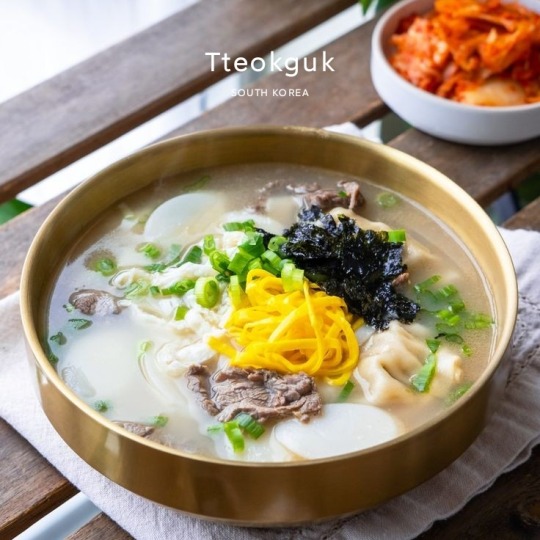






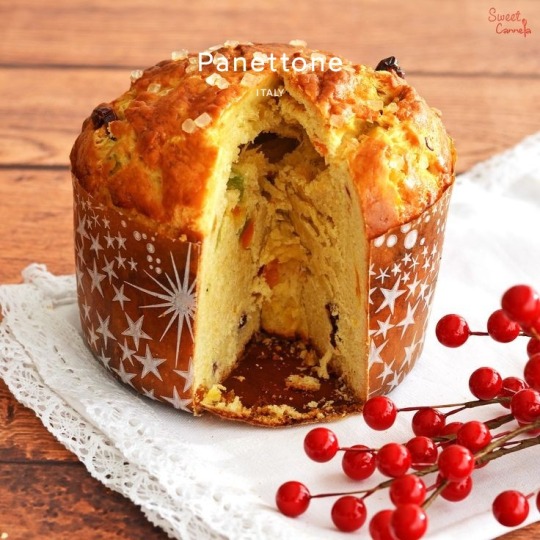

Traditional Holiday Dishes From Around The World
Food is such a wonderful way to experience different cultures, especially during the holiday season. Here are a few traditional holiday dishes from around the world:
Puto Bumbong (Philippines): This is a type of steamed rice cake that's traditionally made during the Christmas season. It's purple in color and is usually served with a sprinkle of brown sugar and shredded coconut.
Daifuku Mochi (Japan): This is a type of rice cake that's often enjoyed during New Year's celebrations. It can be sweet or savory, depending on the filling.
Turron (Spain): Turron is a traditional Spanish Christmas dessert made with almonds, honey, and egg whites. It has a nougat-like texture and comes in various flavors, such as almond, chocolate, and fruit.
Panettone (Italy): This is a sweet bread loaf originating from Milan, typically prepared and enjoyed for Christmas and New Year. It has a cupola shape, with a soft and airy interior beneath a dark exterior. The dough is cured for several days to give it its distinctive fluffy characteristics.
Tteokguk (South Korea): This is a soup made with sliced rice cakes, usually eaten during the Korean New Year. It's a comforting and hearty dish.
Biryani (India): This is a flavorful rice dish made with spices, meat (like chicken or mutton), and sometimes, hard-boiled eggs. It's often served during special occasions and festivals.
Tamales (Mexico): These are a traditional Mesoamerican dish made of masa (a dough made from corn) that's filled with meats, cheeses, fruits, or chilies, wrapped in a corn husk and then steamed. They're often made for special occasions and holidays like Christmas.
Pavlova (Australia): This is a meringue-based dessert named after the Russian ballerina Anna Pavlova. It's crisp on the outside and soft and light inside, usually topped with fruit and whipped cream. It's often served during Christmas celebrations.
Zongzi (Taiwan): This is a traditional dish for the Dragon Boat Festival. The dumplings are made from glutinous rice filled with a variety of ingredients like pork, mushrooms, and chestnuts, then wrapped in bamboo leaves and steamed.
Lo Bak Go (HongKong): This is a traditional dish served during Chinese New Year. It's made from shredded radish and rice flour, and often contains bits of dried shrimp or sausage.
Glühwein (Germany): This is a spiced mulled wine that's traditionally enjoyed during the Christmas season. It's made with red wine, citrus fruits, and a blend of spices like cloves and cinnamon.
Mince Pies (United Kingdom): These are small British sweet pies traditionally served during the Christmas season. Their ingredients are traceable to the 13th century, when returning European crusaders brought with them Middle Eastern recipes containing meats, fruits, and spices.
Isn't it fascinating how each country has its unique holiday traditions? Do you have a favorite holiday recipe? 🍽️🌍
Image sources:
https://foxyfolksy.com
https://pin.it/5C2VruB
https://spainonafork.com
https://pin.it/SNiSvqR
https://thewoksoflife.com
https://oetker.co.uk
https://pin.it/3Hn5Rer
https://www.lebkuchen-schmidt.com
https://cookerru.com
https://sweetcannela.com
https://roadfood.com
https://pin.it/27HuYBR
0 notes
Text
Herb List - WIP
I’m updating this with the names of the plants and adding the meanings as I have time, don’t worry.
A
Acacia - meditation
Acacia (Gum Arabic) - friendship, love, protection, psychic abilities, wisdom
Aconite (Wolfsbane/Monkshood) - invisibility, protection, spirit work
Acorn - courage, fertility, luck, manifestation/power
Adam & Eve Root -
Adder’s Tongue -
African Violet
Agar-Agar - attraction
Agrimony -
Ague -
Alder -
Alfalfa
Alkanet -
Allspice - money drawing, business success
Allspice (Pimento)
Almond -
Aloe - cleansing
Althea Root -
Amaranth -
Amber -
Ambergris -
Anise -
Anise Seeds -
Angelica - attraction, cleansing/purification, cursing, divination, energy, healing, meditation, protection, spell-breaking, success, wisdom
Apple -
Apricot -
Arnica Flowers -
Arrow Root -
Ash -
Asafoetida -
Aspen -
Avocado -
Azalea -
B
Bachelor’s Buttons -
Balm of Gilead -
Balm of Gilead Tears -
Balsam -
Bamboo -
Banana -
Banyan -
Barley -
Basil - peace & happiness
Bat’s Head Root
Bay Laurel
Bay Leaves - protection
Bayberry -
Beans -
Bee Pollen
Beech -
Beef -
Beet -
Beetroot -
Belladonna -
Belladonna (Nightshade) -
Benzoin -
Bergamot -
Betel Nut -
Bilberry Bark (Huckleberry) -
Bindweed -
Birch -
Bistort -
Black Cohosh -
Black Haw -
Black Haw (Devil’s Shoestring)
Black Pepper -
Black Salt -
Black Walnut -
Blackberry -
Blackberry Root -
Bladderwrack -
Bladderwrack (Kelp) -
Blessed Thistle -
Blessed Thistle (Holy Thistle) -
Bloodroot -
Blowball -
Blue Cohosh -
Blue Violet -
Bluebell -
Bluebery -
Boneset -
Borage (Starflower) -
Brimstone (Sulfur Powder) -
Broccoli -
Broom -
Brussel Sprouts -
Buchu
Buckeye (Horse Chestnut) -
Buckthorn -
Buckwheat -
Burdock -
Butcher’s Broom -
C
Cabbage -
Cactus -
Calamus -
Calendula -
Calendula Flower -
Camphor -
Caraway -
Cardamom -
Carnation -
Carob -
Carrot -
Cascara -
Cascara Sagrada -
Cashew -
Cassia -
Catnip -
Cauliflower -
Cayenne Pepper -
Cedar -
Celandine -
Celery -
Celery/Celery Seed -
Centaury -
Chamomile - luck, cleansing
Cherry -
Cherry Bark -
Chervil -
Chestnut -
Chia -
Chickweed -
Chicory -
Chili Pepper -
Chili Powder -
Chives -
Chrysanthemum -
Cilantro -
Cinnamon -
Cinquefoil -
Citronella -
Clary Sage -
Clove -
Clover - friendship & health
Cloves -
Club Moss -
Coconut -
Coffee -
Coltsfoot -
Columbine -
Comfrey -
Copal -
Coriander -
Corn -
Cotton -
Cowslip -
Cramp Bark -
Cranberry -
Crowfoot -
Cucumber -
Culver’s Root -
Cumin -
Curry -
Cyclamen -
Cypress -
D
Daffodil -
Daisy -
Damiana - passion
Dandelion - psychic, second sight
Dandelion Leaf -
Dandelion Leaf/Root -
Dandelion Root -
Dates -
Datura -
Deer’s Tongue -
Devil’s Bit -
Devil’s Bone Root -
Devil’s Claw -
Dill -
Dittany -
Dittany of Crete -
Dogbane -
Dogwood -
Dragon’s Blood -
E
Ebony -
Echinacea -
Egg -
Eggplant -
Elder -
Elecampane -
Elm -
Endives -
Eucalyptus -
Evening Primrose -
Eyebright -
F
False Unicorn Root -
Fennel -
Fenugreek -
Fern -
Feverfew -
Fig -
Figwort -
Fish -
Flax -
Flax Seed -
Fleabane -
Foxglove -
Frangipani -
Frankincense -
Fumitory -
Fumitory (Earth Smoke) -
G
Galangal -
Galangal Root -
Gardenia -
Garlic -
Gentian -
Geranium -
Ginger -
Ginkgo Biloba -
Ginseng -
Goldenrod -
Goldenseal -
Goosegrass -
Gorse -
Grains -
Grapefruit -
Grapes -
Green Pepper -
Guava -
H
Ham -
Hawthorn -
Hay -
Hazel -
Hazelnut -
Heather -
Heliotrope -
Hemlock -
Henbane -
Henna -
Hibiscus -
Hickory -
High John the Conqueror -
Holly -
Holy Thistle -
Honey -
Honeydew -
Honeysuckle -
Hops -
Horehound -
Horseradish -
Huckleberry -
Hyacinth -
Hydrangea -
Hyssop -
I
Indian Paintbrush -
Iris -
Iris Root -
Iris Root (Orris Root) -
Irish Moss -
Ivy -
J
Jasmine -
Jezebel Root -
Job’s Tears -
Juniper -
K
Kava Kava -
Kelp -
Kiwi -
Knotweed -
Kola Nut -
Kumquat -
L
Lady Slipper -
Lady’s Matle -
Larch -
Larkspur -
Laurel -
Lavender - passion, sleep
Leek -
Lemon -
Lemon Balm -
Lemon Verbena -
Lemon Verbena (Vervain) -
Lemongrass -
Lettuce -
Licorice -
Lily -
Lily of the Valley -
Lime -
Linden -
Liverwort -
Lobelia -
Lotus -
Lotus Root -
Lovage -
Lucky Hand -
Lucky Hand (Orchid Root) -
Lucky Hand Root (Orchid Root) -
M
Mace -
Magnolia -
Magnolia Flowers -
Maidenhair -
Maidenhair Flowers -
Mandarin -
Mandrake -
Mango -
Maple -
Marigold -
Marjoram -
Marshmallow -
Marshmallow Root -
Mastic -
Meadowsweet -
Melon -
Mesquite -
Milk Thistle -
Mimosa -
Mint -
Mistletoe -
Moonwort -
Morning Glory -
Moss -
Motherwort -
Mugwort - psychics
Mulberry -
Mullein -
Mushrooms -
Musk -
Mustard -
Mustard Seed -
Myrrh -
Myrtle -
N
Narcissus -
Nectarine -
Nutmeg - good luck
Nuts -
O
Oak -
Oak Moss -
Oats -
Oatstraw -
Oleander -
Olive -
Olive Leaf -
Onion -
Orange -
Orange Blossom (Neroli) -
Orchid -
Oregano -
Orris Root -
Orris Root Powder -
P
Palm -
Pansy -
Papaya -
Paprika -
Papyrus -
Parsley -
Passion Flower -
Passion Fruit -
Patchouli -
Pea -
Peach -
Peanut -
Pear -
Peat Moss -
Pecan -
Pennyroyal -
Peony -
Peppermint -
Periwinkle -
Persimmon -
Pikaki -
Pimpernel -
Pine -
Pine Nut -
Pineapple -
Plantain -
Plum -
Plumeria -
Pokeroot -
Pokeweed -
Pomegranate -
Poppy -
Poppy Seed -
Pork -
Potato -
Prickly Ash Bark -
Prune -
Pumpkin Seed -
Q
Quassia -
Quince -
R
Radish -
Ragweed -
Raisins -
Raspberry -
Raspberry Leaf -
Red Clover -
Red Pepper -
Red Willow Bark -
Rhubarb -
Rice -
Rose -
Rose Hips -
Rosemary - powerful guardian
Rose Petals - love, romance, good luck for endeavors of the heart
Rowan -
Rue -
Rye -
S
Safflower -
Saffron -
Sage -
Sagebrush -
Sandalwood -
Sasparilla -
Sassafras -
Saw Palmetto -
Sea Salt -
Sesame -
Sesame Seed -
Shave Grass -
Sheep Sorrel -
Skullcap -
Skunk Cabbage -
Slippery Elm -
Snakeroot -
Snapdragon -
Solomon’s Seal -
Solomon’s Seal Root -
Southern Wood -
Sow Thistle -
Spanish Moss -
Spearmint -
Spiderwort -
Spinach -
Squaw Vine -
Squill -
Squill Root -
St. John’s Wort -
Star Anise -
Stinging Nettle -
Strawflower -
Strawberry -
Sugarcane -
Sumac -
Summer Savory -
Sunflower -
Sweet Bugle -
Sweet Pea -
Sweetgrass -
Sycamore -
T
Tangerine -
Tansy -
Taragon -
Tea Leaves -
Thistle -
Thyme - luck, peace & prosperity
Toadflax -
Tobacco -
Tomato -
Tonka Bean -
Tormentil -
True Unicorn Root -
Tuberose -
Turmeric -
Turnip -
U
Uva Ursi -
V
Valerian -
Vanilla -
Venus Fly Trap -
Vetiver -
Vinegar -
Violet -
W
Walnut -
Watercress -
Wheat -
White Willow Bark -
Wild Cherry Bark -
Willow -
Wintergreen -
Wisteria -
Witch Hazel -
Witches Burr -
Witches Grass (Dog Grass) -
Wood Aloe -
Wood Betony -
Woodruff -
Wormwood (Absinthe) -
Y
Yams -
Yarrow -
Yarrow Flower -
Yellow Dock -
Yellow Pepper -
Yerba Mate -
Yerba Santa -
Yew -
Ylang Ylang -
Yohimbe Bark -
Yucca -
« »•« »•« »
Created: 10/01/2019
Last Updated: 10/03/2019
#witch#beginner witch#witchblr#magical herbs#masterpost#kitchen witch#green witch#grimoire#book of shadows
201 notes
·
View notes
Text
Top 5 Types of Cuisines Around The world
Eating is something you love. You haven't tried every cuisine in the world, have you? Globally, most nations and locations have their cuisine. Multi-cuisine restaurants serve various continental meals. For instance, a multi-cuisine restaurant serves Indian, Chinese, Italian, American, and French dishes.
Different cooking techniques, regional ingredients, and spice combinations are used in multicultural cuisines. In addition, some cuisine cultures have developed from the fusion of foods from several nations. This has led to the development of delectable meals that are a delight to eat.
A wide variety of culinary traditions exist around the world. There are well-known cuisines in France, Thailand, Italy, India, and China. You can also find restaurants serving Vietnamese, Hungarian, Lebanese, and Moroccan cuisines in big cities.
Check 5 Types of Cuisines Around The world

Types of Cuisines
Spanish Cuisine
In Spanish cuisine, as in many Mediterranean nations, seafood plays a vital role. The traditional seafood paella is made up of paprika, saffron, lobster, squid, shrimp, mussels, and paprika. However, Spain's cuisine is more diverse than just seafood. This famous cuisine also includes Serrano and Iberico hams. Spanish tapas also include chorizo sausage, mushrooms, and grilled beef.
Lebanese Cuisine
Cuisine from other Mediterranean nations is incorporated into Lebanese cuisine. Olive oil, garlic, and other seasonings are used to prepare chicken, fish, lamb, and goat meat. These are usually served with pita bread and raw or grilled veggies.
Chickpeas are also an essential ingredient in Lebanese cuisine. A tasty, nutty hummus dip can be made by cooking and blending them with olive oil, tahini, and lemon juice.
In addition to traditional Mediterranean desserts such as baklava and halva, Lebanese sweet recipes often incorporate fresh or dried dates.
Turkey Cuisine
Turkish cuisine exemplifies the blending of Asian, European, and Middle Eastern culinary traditions. Turkish cuisine includes delectable dishes such as eggplant, stuffed dolmas, lamb kebabs, and mouthwatering vegetable soups. Nuts, such as hazelnuts, walnuts, and chestnuts, are frequently used as ingredients in both savoury and sweet dishes. Yogurt, a Turkish staple, is typically served as a side dish to a variety of vegetable and meat dishes. Turkish coffee, hot black tea, and ayran, a type of yoghurt drink, are all popular beverages in Turkey.
Thai Cuisine
Thai food's intensely spicy flavours are created by combining sweet, sour, and hot ingredients. Pad thai, green curry, tom yum goong are some of the best Thai dishes. Thai cuisine also frequently includes rice or noodles.
Mexican Cuisine
Mexican cuisine is the top most popular in the world. Tacos, enchiladas, tortillas, and quesadillas are now served in many countries around the world. Mexican food is popular on the streets because it is tasty, spicy, and easy to wrap in tortas or tortillas. Mexican ethnic cuisine may include spicy dishes, unusual fruits, grilled goats, meat with eggs, and pork. Mexico produces the best avocado guacamole.
1 note
·
View note
Text
【金鐘】Maison ES ❦ 星街上的清爽微風~迷人夏日新餐單
香港近日天氣超濕又熱,令人非常難受!還好不少餐廳貼心推出夏日餐單,其中特別推介 Maison ES 滿有海鮮元素及亞洲風味的清新菜式, 賣相美、味道又好,宛如一陣清爽微風,令人胃口大開!

灣仔(其實更近金鐘)星街一帶的風情從來都份外悠閒,位於電氣道斜坡上的 Maison ES,店內外都放置了大量花草植物,很有生氣,店內更滿佈創辦人兼主廚 Esther Sham 自世界各地親自搜購的古董擺設,環境非常青綠迷人!


天氣炎熱,就坐後大家紛紛以果汁、美酒來消暑;好喜歡好喜歡這裡的可愛紙飲管,不過我的選擇是白酒,好配搭接下來的海鮮頭盤/主菜!要讚這裡的麵包很夠熱暖,塗上牛油味道很好,但要留肚只分享半件就好。

首道頭盤的 Hokkaido Scallop 北海道帶子刺身 ($198) 上檯了!鮮美嫩甜的帶子,伴上鮮甜濃郁的海膽,雙重鮮味在口中併發;吃時可沾上青瓜汁及紅薑啫喱,令味道更豐富。而黑色那件是沾上紫菜粉的「別注版」帶子,吃來多一份鹹鮮感~

接下來又有 48 Months Bellota Ham ($188),48 個月西班牙 Bellota 火腿本身已經很好吃,再伴上清甜蜜瓜湯及炸豬皮,是傳統 Ham & melon 的昇華版,吃出一口油潤、清甜、滿足~

驚喜陸續來;Heirloom Tomatoes 香烤及醃製復古番茄 ($168) 看來與一般番茄沙律差不多,但其實中間是麵豉漬有機蛋黃,蛋香蛋汁拌著清甜番茄同吃,那滋味真是不得了;再連同藜麥、日本水菜、紫蘇及薑豉汁等,絕對是我吃過味道最豐富繽紛的番茄沙律!

頭盤環境水準不���,難得主菜繼續氣勢如虹:Spanish Pork Belly ($340) 以沖繩黑糖及醬油煮起,加上苦瓜、豆腐及芥末作配料而成,賣相邪惡又吸引!又,雖然寫是西班牙豬腩,但味道及配搭都十分滬式,愛吃東坡肉的我樂透了,那管「相煎太急」,快給我來兩大塊肉!

接著的 Japanese Black Abalone 慢煮日本黑鮑魚 ($380) 也很精彩,日本鮑魚從來都是鮑魚界的明星,鮮甜美妙,滋味比南非/澳洲鮑優勝太多,點上黑色鮑肝醬更令人無可抗拒。底下的車厘茄珍珠麵也清爽好吃,都被我吃光了!

另一款海鮮主菜是 Geoduck Linguine 象拔蚌意粉 ($360),沒想到象拔蚌可以用來煮意粉,而且與惹味 XO 醬、乾瑤柱有那麼美妙的化學作用,大家真要小心吃不停口啊!

最後一款主菜是 Waygu A3 Sirloin ($480),油香十足、色澤嫣紅迷人的日本 A3 和牛西冷經過燒烤切成粒狀奉客,碟上另備燒飯糰、蒜片、新鮮山葵;吃時其他都可以不管,但一定要蘸加有鰻魚汁的溫泉蛋,那又甜又香的滋味實在棒極,令人超難忘啊!

來到甜品環節,首先是 Chestnut Candy ($108),由糖煮栗子忌廉茸配超好吃的 Valrhona 70%黑朱古力 Brownie,加上脆蛋白、杏片及麥提莎粒而成,滋味香甜不過膩,吃時配杯咖啡最妙!

另一款甜品是由芝麻湯丸變奏而來的 Black Sesame Tang Yuan ($98),黑芝麻布丁伴北海道紅豆茸,加上白芝麻湯丸及花奶雪糕,內容中西並匯,味道與口感都十分豐富,最愛是那甜美的花奶雪糕,吃完暑氣全消~

最後還有 Petit Fours,是美味的綠茶紅豆卷,吃完摸摸我圓鼓鼓的肚腩,徹底滿足了~

除了以上夏日新菜式,店內也有$988/位的 Tasting Menu(可選 3 starters + 2 mains + 1 dessert),對追求食物質素、創意及舒適環境的朋友,絕對是理想聚餐地啊~
Maison ES
地址:灣仔星街1A號地舖 (入口位於電氣街)
** 想得知最新飲食情報,可追蹤 甜魔媽媽;欲得知甜魔一家消息,就追蹤 Matthew and Chloe 吧~
飲食資訊由熱新聞提供
原文連結: 金鐘 ❦ Maison ES ❦ 星街上的清爽微風~迷人夏日新餐單
更多相關內容

新加坡美食之最 ✢ 沙嗲軒 Satay Inn ✢ 富麗敦酒店客廚獻技

Yan Lo
甜魔媽媽的新天地,在這裡與大家分享美食、育兒,以及旅遊資訊~~~24小時為你介紹不同的餐廳,各國美食精選等!
2 notes
·
View notes
Text
Back to Astons Specialities at Sembawang Shopping Centre for their western food. This round I ordered something other than the Crispy Fried Fish for mum. Got her the Seafood Marinara (S$10.90) pasta which came with a soup of the day – Mushroom Soup. But alas, she said she don’t like the mussels. :(

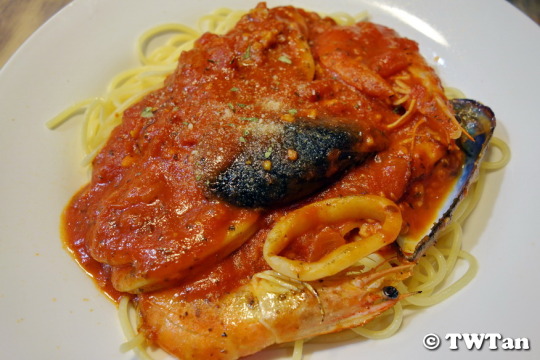
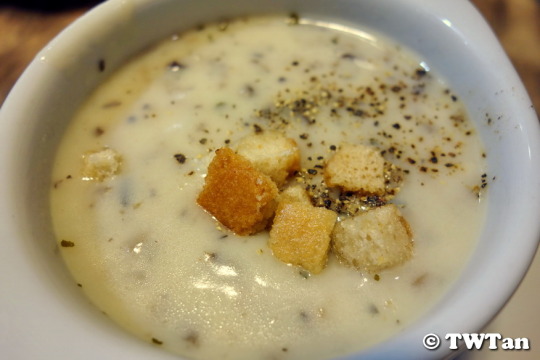
The side order I made was for this Truffle Chips (S$5.90) in which a few dashes of truffle powder was added. Both mum and I enjoyed this hand sliced crispy potato chips perfumed with the aroma of truffle.
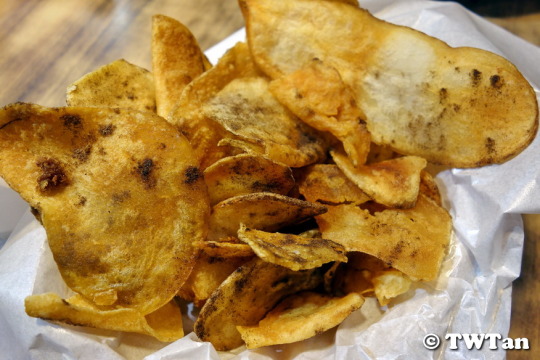
My Spanish Chestnut Pork (S$17.90) with two sides of garden veggies and potato wedges. It was served with a cup of brown sauce and not the apple sauce I expected. Loved the tender and juicy pork still a little pinkish in the middle.
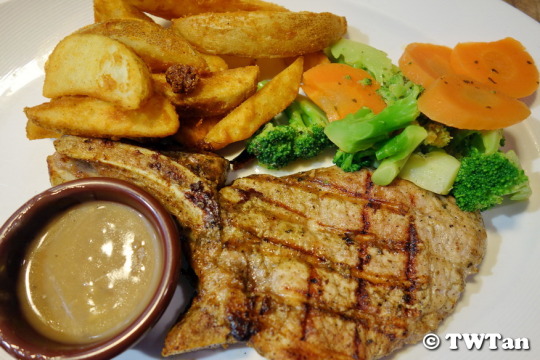
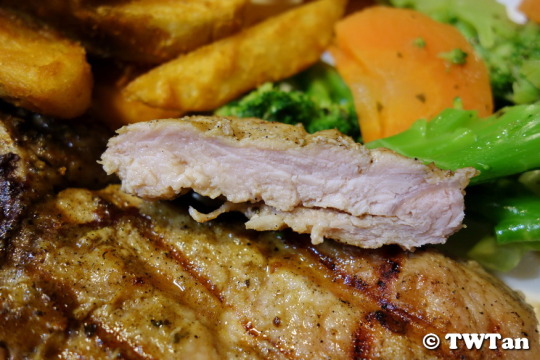
#Astons Specialities#Sembawang Shopping Centre#Restaurant#Western#Seafood Marinara#Seafood#Prawn#Mussel#Squid#Tomato Sauce#Pasta#Spaghetti#Mushroom Soup#Truffle Chips#Spanish Chestnut Pork#Pork Chop#Grilled#Charred#Vegetables#Potato Wedges#Dinner#Food#Buffetlicious
18 notes
·
View notes
Text

✅SANTA MONICA RESTAURANT WEEK
Included: 📞,💲📍
JANUARY 6-12, 2020
2020 MENU
Azulé Taqueria (The Gallery)
1315 Third Street Promenade
Santa Monica, CA 90401
(310)-598-5598
Open Daily
11:00 AM - 9:00 PM
Duck Carnitas Taco Combo
Kumquat habanero marmalade, pickled radishes, Fresno chili. Served with rice, beans and a drink.
$12
Bergamot Cafe
2525 Michigan Ave, #A3, Santa Monica, CA 90404
(310)-828-4001
Open Daily
8:00 AM - 9:00 PM
Avocado, Kumquat and Candied Walnut Salad with Grilled Salmon
Crisp romaine lettuce tossed with fresh kumquats, feta cheese, candied walnuts and topped with a 6 oz. grilled salmon fillet. Tossed with honey white balsamic dressing.
$13.99
BOA Steakhouse
101 SANTA MONICA BLVD, SANTA MONICA, CA 90401
(310)-899-4466
Hours differ
Chef’s Bite
Crispy chicharrón with kumquat marmalade, wild rice, cured egg and achiote
$6
Calabra
Koji Fried California Quail
Kumquat and Calabrian chile sweet and sour, cilantro and mint
$18
Chinois On Main
Quail with Pineapple & Kumquat Sauce
Crispy glazed quail with grilled pineapple and kumquat sauce
$29.50
Colorado Kitchen
2501 Colorado Ave, Suite 120, Santa Monica, CA, 90404
(424)-330-3150
Monday-Friday 7:30AM-10:30AM & 11AM-2:30PM
Rosemary & Kumquat Focaccia Sandwich
Roasted pork, provolone, herb aioli, pickled onions, kumquat Giardiniera. Served with baby lettuce side salad with kumquat vinaigrette.
$11.50
The Curious Palate
Spicy Broccolini
Sautéed broccolini and water chestnuts topped with house candied kumquats and a Thai chili anchovy sauce
$10
Dolcenero Gelato
2400 MAIN STREET A3, SANTA MONICA, CA, 90405, UNITED STATES
(323) 540-6263
Sunday-Thursday 12:00pm-10:30pm
Friday and Saturday 12:00pm-11:30pm
Kumquat Sorbet
Creamy, soft, tender and citrusy sorbet
$5
The Dudes’ Brewing Company
395 Santa Monica Place, #304
Santa Monica, CA 90401
(424) 271 - 2915
Monday-Wednesday 12pm-10pm
Thursday-Friday 12pm-11pm
Saturday 11am-11pm
Sunday 10am-10pm
Goat Cheese Crostini
Herbed goat cheese topped with kumquats on toasted house made bread
$5
El Cholo
1025 Wilshire Blvd Santa Monica CA 90401
(310)-899-1106
Mon-Sat 11:00 AM - 11:00 PM
Sun 11:00 AM - 9:00 PM
Fish Tacos with Kumquat Salsa
Pan-seared Mahi Mahi with kumquat salsa on handmade corn tortillas
$18.95
Élephante (note: restaurant will be closed January 7 & 8)
https://www.google.com/search?q=elephante+santa+monica&ie=UTF-8&oe=UTF-8&hl=en-us&client=safari#
Kumquat and Fennel Salad
With taggiasca olives, arugula, red onion
$16
Fia
2454 WILSHIRE BLVD
SANTA MONICA, CA 90403
(424) 280 - 4196
MONDAY - FRIDAY : 5 PM - 12 AM
SATURDAY : 11 AM - 2:30 PM & 5 PM - 12 AM
SUNDAY : 11 AM - 2:30 PM & 5 PM - 9 PM
Roasted Duck, Spiced Turnips and Poached Kumquats
$46
FIG Restaurant at Fairmont Miramar Hotel & Bungalows
Charred Carrot Salad
Weiser’s charred carrots, JJ Lone Daughter’s avocados, kumquat, honey and chipotle
$16
The Independence
205 BROADWAY, SANTA MONICA, CA 90404
(310)-458-2500
BRUNCH: 10:30AM - 3PM, Sat - Sun
LUNCH: 11:30AM - 3PM, Mon - Fri
DINNER: 6PM - close, Everyday
AFTERNOON DELIGHTS: 3PM - 6PM, Mon - Fri
HAPPY HOUR: 3PM - 6PM, Mon - Fri
King Salmon Tartar
Cucumber, avocado, kumquat
$16
Spiced Kumquat Whiskey Smash Cocktail
$12
Kye’s
1518 Montana Ave.,
Santa Monica, CA 90403
(310) 395-5937
Open M - F 10AM - 8PM, S & S 11AM - 7PM
Kumquat Fruity Boba
Kumquats, coconut milk, Harmless Harvest Raw Coconut Water, preservative free boba, Medjool dates and vanilla
$8
Lanea
(424) 265-7437
LOCATION
217 Broadway, Santa Monica, CA 90401
HOURS
monday - thursday 5p–late
friday 5p-2a
saturday 11a–2a*
sunday 11a–late*
Kumquatargarita
Cazadores blanco tequila, Clement liqueur d’orange, citrus, house lime salt, muddled kumquat
$12
Little Prince
2424 Main St
Santa Monica, CA 90405
(310)356-0725
Dinner Sun - thurs
5:30pm-10pm
Dinner Fri + Sat
5:30pm-11pm
Brunch Sat + Sun
9am-3pm
Pumpkin Toast with Burrata, Kumquats and Pumpkin Seed Crumble
Seasonal farmers market pumpkin and notes of citrus on Clark Street Bread sourdough from the wood oven
$17
Little Ruby
109 Santa Monica Blvd
Los Angeles, California
(424)322 8353
Whipped Ricotta Toast with Kumquat Honey
$10
The Lobster
1602 OCEAN DRIVE
SANTA MONICA, CA 90401
(310) 458-9294
SUNDAY - THURSDAY: 11:30AM-10:00PM
FRIDAY - SATURDAY: 11:30AM-11:00PM
HAPPY HOUR (MON-FRI): 3PM-6PM
Kumquat Upside Down Cake
With whipped mascarpone and blueberry compote
$10
Longitude Bar + Restaurant at Le Méridien Delfina Santa Monica
Seared Duck with Candied Kumquats + Chef’s Choice Dessert
Pan-seared duck breast, candied kumquat with braised endives, in kumquat sauce and blueberry duck jus. Dessert included.
$68
Lunetta All Day
2420 Pico Boulevard Santa Monica, CA 90405
(310)-581-4201
Mon - Sat 8:00 AM - 9:00 PM
Sun - 8:00 AM - 3:00 PM
Tacos with Kumquat Salsa
Grilled Spanish octopus tacos, pasilla rubbed carnitas tacos, Wagyu steak tacos, marinated Jidori chicken tacos; all are served with a pineapple kumquat salsa & house made tortillas
$12 – $16
Lunetta
Duck Confit
Glazed baby turnips and kumquats, orange vanilla sauce
$19
Margo’s
Kumquat Roasted Chicken Breast
Roasted chicken breast, kumquat jus, green olives, Cipollini onions, roasted root vegetables
$29
Kumquat Margarita
Tequila, kumquat jus, lime juice, Cointreau
$16
Massilia
Pear & Kumquat Salad
Arugula, avocado, snap pea, quinoa, pomegranate seed
$13
Meat On Ocean
Duck Rillettes
With kumquat preserves and goat cheese
$14
Michael’s Santa Monica
Baja Style Wild Yellowtail
Crudo of diced, wild, inada (baby yellowtail) set in an aguachile sauce made of market chiles and kumquats, garnished with sliced kumquats, radishes and cilantro
$13
Obicà
Kumquat Mojito
Mint leaves, kumquats, fresh lime juice, simple syrup, white rum, club soda
$15
Red O Taste of Mexico
Spiced Kumquat Hot Toddy
Whiskey, cinnamon, cloves, kumquats
$12
Rosti Tuscan Kitchen
Kumquat Marmalade Flat Bread
Flat bread with gorgonzola cheese, mozzarella cheese, kumquat marmalade spread, heirloom cherry tomatoes, arugula and fresh burrata cheese on top
$16
Scoops Ice Cream & Treats
Kumquat Caramel Date Ice Cream
Hand-crafted ice cream made with fresh organic kumquats, Medjool dates and a lightly salted caramel swirl
$6 single scoop, $8.50 double scoop
Seaside on The Pier
Kumquat Glazed Salmon
With kumquat roasted parmesan potatoes and mixed vegetables
$20.95
Kumquat Kombucha Margarita
$14
California Kumquat Salad
Mixed greens, kumquat agave vinaigrette, kumquats, feta cheese, pistachios, sun-dried tomatoes, avocado
$14.95
Socalo
Salmon Poke
Kumquat ponzu, serrano, cucumber, rice, fennel and sesame seeds
$16
Sonoma Wine Garden
Moulard Duck Breast
Pan-seared with preserved kumquat jus, Meyer lemon infused celeriac puree
$28
Kumquat Lemon Drop
Tito’s Vodka, St. Germain, lemon, Fair Kumquat Liqueur
$12
Stella Barra Pizzeria & Wine Bar
Baby Greens and Shaved Fennel Salad
Tossed with Tropea onions, Sicilian capers, kumquat vinaigrette
$14.95
Sushi Roku
Fluke Kumquat Sashimi
Thinly sliced sashimi topped with kumquat jam and yuzu vinaigrette
$12
Tiato
Winter Kumquat Salad
Roasted Brussels sprouts, kale, red cabbage, grapes, red onion, walnuts and ginger kumquat dressing
$12
Upper West
Curry Spiced Butternut Squash
Fennel chow chow, pea tendrils, kumquat marmalade, lime
$11
0 notes
Text
One of my favourite things about visiting a new city is exploring the culinary delicacies of each destination. Get ready to indulge, as Rome has no shortage of restaurants or pasta. I’m pretty sure I could eat pasta every day.
Dining in Rome
Aroma Rome

Michelin starred AROMA is located in the Penthouse of the Palazzo Manfredi. The menu offers classic Italian dishes on an outdoor terrace with majestic views of the Colosseum.
The 28 seat restaurant is ideal for a special lunch or dinner. Roman-born Chef Di Lorio has been Aroma’s head chef since it opened in 2010. He has developed a menu that highlights traditional Italian cooking with fresh ingredients.
I would recommend the tasting menu where Giuseppe Di Iorio Executive Chef, will accompany you in a renewed gastronomic journey in which he reveals his philosophy and culinary essence, made of creativity, passion, research, technique and respect for the raw material.
Aroma is probably one of the priciest restaurants in Rome. It can easily set you back $400 Euros for a lunch for two, but if you are looking for a unique dining experience with exquisite food, then it is worth the price.
READ NEXT: WHERE TO STAY IN ROME
Trattoria da Paolo

Alicia of Miles Less Traveled
Trattoria da Paolo, Via di S. Francesco a Ripa, 92, 00153 Roma RM, Italia di S. Francesco a Ripa, 92, 00153 Roma RM, Italy
Resting on the corner of a small side street in the hipster neighbourhood of Trastevere, this Roman restaurant does not look like much at first glance. The tables are adorned with the stereotypical red and white checkered clothes, the menu is as simple as can be and it’s not close to any specific attraction. But don’t be fooled. The simplicity and hominess of Trattoria da Paolo is what makes it so good.
The lone server, Angelo, speaks mostly Italian but still somehow manages to communicate with those visiting who don’t, making jokes at the guest’s expense in a good-natured way that will have you feeling like your at Grandpas house. The food is comforting and delicious: bowls heaped high with varying kinds of pasta, sauces, and meats and seafood, stewed meats that fall off the bone, and the special antipasto plate that changes nightly. Unlike other restaurants that taste this good in Rome, eating here won’t break the bank. The average meal will cost you roughly 15 Euro.
In the Summer, like most Rome restaurants, the tables spill out onto the sidewalk, lit softly from the indoors. It is quintessential Roman: the friendly yet gruff staff, plate after plate of delicious, hearty pasta, and a meal that lasts hours from sheer enjoyment.
Romeow Cat Bistrot
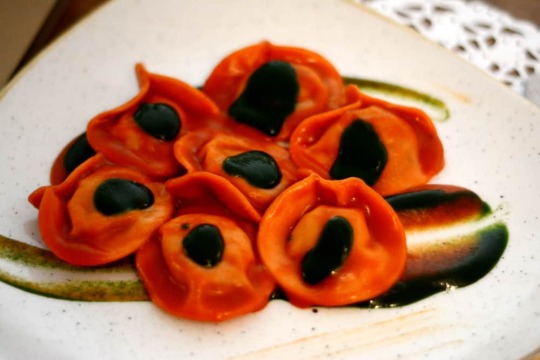
Angela from Rome Actually
One of my favourite vegetarian restaurants in Rome is Romeow Cat Bistrot (Via Francesco Negri 15). Bistrot and restaurant, it’s located in the Ostiense area, the neighbourhood home to the relics of Rome’s industrial archaeology. All around the restaurant you can visit places like the Centrale Montemartini Museum, the old Gasometer, and view the street art along Via Ostiense and Via del Porto Fluviale streets.
Romeow Cat Bistrot serves only vegan dishes prepared with no animal products. The menu and the ingredients change depending on the season, so in summer you would find more refreshing dishes made with veggies like zucchini, tomatoes and eggplants, while Fall and winter are the time for broccoli, pumpkin, chestnuts, lentils and so on.
The dishes are delicious and the combination of ingredients daring yet spot-on. Some of the courses I had included dumplings on a tempeh ragout, spinach and ginger, soy and chickpea burger with chips on paprika and avocado cream, and crunchy rolls stuffed with Sicilian broccoli and toasted hazelnuts.
The restaurant is not a cheap eat in Rome, with most fares ranging from 12 to 15 euro up for the main courses and between 8 to 10 euros for starters and appetizers.
Here, I liked the serene ambiance and the cats wandering around. While guests are asked not to stress the furry hosts by waking them, grabbing them or attracting them with the food, they are welcome to pet them if the cats make the first move and get close for some cuddling.
If alongside traditional foods you also like to try more adventurous flavours and dishes, you will love Romeow.
Pastificio Guerra

Melissa of The Family Voyage
Our favourite restaurant in Rome is Pastificio Guerra near the Spanish Steps. While it’s not a traditional sit-down restaurant, this spot is an absolute can’t-miss. The menu rotates daily, but all of the kinds of pasta and sauces are made fresh in the kitchen right behind the counter. Everything is served without fanfare in takeaway containers and that’s just fine with us – Pastificio can focus on making some of the city’s best pasta without worrying about a wait staff or charging more for a fancy presentation.
The most remarkable thing about Pastificio is that it’s some of the best pasta you’ll ever eat, yet one of the cheapest meals you can find at a restaurant anywhere: just €4 for pasta and wine. No joke. They’ve been serving up deals to tourists and locals alike for a century!
Deciding when to visit Pastificio is a bit of an art – come at peak times and you could wait in line for ages, come too late and you’ll find fewer options from the day’s menu. Once an item is gone, it’s gone! If you come at a time when the shop isn’t too busy, you’ll be able to stand around the shop’s perimeter and use the small counters to stand for your meal while you ogle the packages pasta for sale.
Trattoria Sora Lella

Sherrie at TravelbyAsherrieaffair
One of the most historic restaurants in Rome is the Sora Lella, located on the only little island on the Tiber River that runs through the city. The Roman people may have turned their backs on the Tiber River, but they will never turn their backs on Sora Lella. Opened in 1959 by Elena “Lella” Fabrizi an actor herself and the sister of Italy’s famous actor Aldo Fabrizi. Immediately it became a popular place for movie stars visiting the city like Aldo himself, and Alberto Sordi.
Today the restaurant is still run by family members as they keep up the wonderful tradition of making delicious very authentic Italian dishes. Earning a well-deserved Michelin Star. You will find some items on the menu that you will recognize but it the regional food that they are famous for. Like Sweetbreads of Lamb with Marsala wine, Roman-Style Veal tripe with tomato sauce flavoured with mint and pecorino cheese, Home-made Gnocchi in a classic Roman sauce with seasoned pork cheeks, tomatoes and Roman pecorino cheese. The desserts especially their Tiramisu are delizioso!
The cost of meals are a little above average in the price range, but so worth it! The best part is the family atmosphere and the history that follows this trattoria. We enjoy going every time we are in Rome. Letting them know that we are distant relatives when we take our seats, they treat us like close family members each and every time.
Nonna Betta

Katy of Untold Morsels
In the heart the Jewish Ghetto district, Nonna Betta is the place to go for home-style kosher cooking in Rome. Jews have played an important part in the city’s food culture for over 2,000 years and this heritage is celebrated at Nonna Betta. The restaurant is cozy and inviting thanks to low hanging wrought iron lanterns hovering over wooden tables. And the staff are more than happy to take you through the menu full of Roman Jewish classics.
Meals at Nonna Betta are homely and hearty. Must try dishes include agnolotti pasta with stracotto (pot roast sauce), pumpkin flowers and baccalà (codfish) with tomato and onion sauce. But most people come for the famous carciofo alla giudia (Jewish style artichokes). Deep fried and seasoned with salt and chilli, they are one of Rome’s iconic dishes and you’ll wonder why you ordered just one serve. For dessert, you can try Middle Eastern style treats like baklava and or the house specialty ricotta cheesecake.
After dining, take a walk through this fascinating part of Rome. The impressive ruins of the Portico d’Ottavia, an ancient Roman walkway, are just steps from the restaurant. Stroll a little further and you reach Teatro Marcello, a huge amphitheatre and entertainment space founded by Julius Caesar.
Nonna Betta is a casual and popular eatery with Romans as well as tourists so it is wise to book ahead, particularly for dinner and on weekends. Expect to pay €20-€30 for a two-course meal without wine. http://www.nonnabetta.it/
Salumeria Roscioli

Ayngelina of Bacon is Magic
It’s easy to get caught in a tourist trap in Rome, I’ve certainly gone places based on top picks on travel review sites only to find out that only tourists eat there. Or even worse, Anthony Bourdain ate somewhere amazing and featured it on his show and it becomes a completely different place in order to deal with the new influx of people.
But Roscioli is where locals go. It’s been around for four generations and where Italian chefs visit when coming to Rome. I follow a lot of chefs who own Italian restaurants in North America. So when planning a trip to Rome I asked them where I should eat and overwhelmingly they said Roscioli was one of their favourites.
But you must love cured meat like prosciutto and lardo di Colonnata because a salumeria is a deli and this one also has a restaurant.
It’s easy to get to, nearby Campo dei Fiori and Via Arenula. I recommend sitting at the bar instead of a table. You can see more of the action and talk to the servers who will share their favourite places to eat.
This is a splurge and you could easily spend $100. You can eat more economically but they serve the best quality burrata in Italy, and the cured meat is incredible. If you’d like something more substantial you cannot miss the cacio e pepe pasta.
Reservations are a must and most hotel concierges know this spot well enough to get you one. If you’re staying in an apartment you can book online at http://www.roscioli.com/
If you love this spot you must also visit their bakery around the corner at Via dei Chiavari.
Via dei Giubbonari, 21/22, 00186 Roma
Trattoria Vecchia Roma

Claudia of My Adventures Across the World
There is no doubt that one of the top things to do in Rome is eating at Trattoria Vecchia Roma, one of the most delicious restaurants in the city. Located in Via Ferruccio 12 B/C, a rather hidden street near Vittorio Emanuele square and Vittorio Emanuele metro station, it’s a favourite of locals and has yet to be discovered by tourists, who can be easily spotted inside as they are the only ones sipping cappuccino after a meal (no Italian would do that!). This is probably due to the fact that no major tourist attractions are nearby (though the area is definitely central, between Stazione Termini and San Giovanni in Laterano).
Trattoria Vecchia Roma serves typical dishes of Roman cuisine, such as “abbacchio alla scottadito” (chargrilled lamb chops); “tonnarelli cacio e pepe” (tonnarelli pasta in a cheese and pepper sauce); “bucatini all’amatriciana” (bucatini pasta in amatriciana sauce, made with guanciale and tomatoes). There is a fantastic salad bar to pick a variety of vegetable dishes: the most typical one is puntarelle, which is made with the sprouts of chicory and a simple dressing of olive oil, garlic, salt, pepper, and anchovies; another one is lightly stir-fried chicory with garlic and chilli. Last but not least, the zucchini flowers are to die for: stuffed with anchovies and a bit of mozzarella, dipped in a light batter and fried until moist yet crispy, this is one of the most typical dishes of local cuisine.
The average cost of a meal at Trattoria Vecchia Roma is 20 to 22 euro. If you go for the set meal, it’s 27 euro for a full meal which includes appetizers, a pasta course, a meat course, side dishes of salad or roast potatoes, dessert, coffee, drinks and liquors.
Portions are huge, so unless you are very hungry, don’t go for the full menu and share at least some of the dishes.
What’s special about Trattoria Vecchia Roma is that it’s retained its local character since the day it was founded, in 1916 (yes, it’s been around for over 100 years!); the food is delicious and the prices are honest. It’s a popular place, so make sure to call in advance to reserve a table. And please, do not order a cappuccino after your meal. You’ll be served one, but you’re going to be frowned upon!
Joseph Ristorante

Kate of Our Escape Clause
Far from the crowds of the Colosseum and tucked into a more local neighbourhood in Rome sits Joseph Ristorante.
It’s quiet, unpretentious, and during lunch on weekdays, arguably the best deal in town.
During lunch on Monday – Friday, they run a lunch special that covers a meal (usually a pick of around 6-8 different kinds of pasta or a meat dish), bread, wine, and dessert… all for 8 Euros flat! Service is friendly and easy-going (though mostly in Italian–brush up on your restaurant Italian before you go!), and we love the casual environment.
The food is wonderful–we’re obsessed with the carbonara in particular–and the atmosphere perfect. For dessert, we’re usually partial to the tiramisu or the pannacotta with caramel–but the chocolate mousse is fantastic as well.
While plenty of tourists do come by, you’ll hear more Italian than English spoken at the tables around you during these lunches.
We originally stumbled across this restaurant due to staying near it: odds are, you will have to intentionally choose to come out here, as there aren’t any major attractions nearby. Joseph Ristorante is less and a 5-minute walk from the Line A Cornelia metro stop–just an extra 3 stops or so past the Vatican! Joseph Ristorante would make a perfect stop after visiting the museums in the morning, especially if you have an all-day metro pass.
We’ve eaten here at least half a dozen times during our various visits to Rome… and we fully intend to keep coming back whenever we’re in town.
Antica Trattoria da Pietro al Pantheon
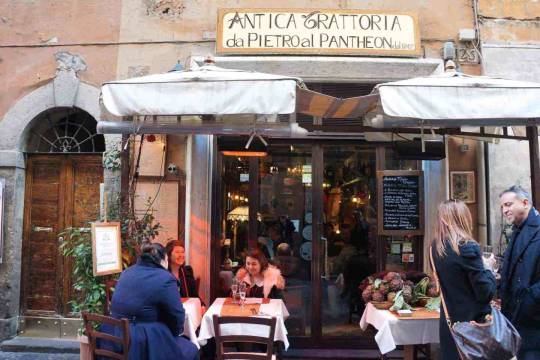
Kate of Wanderlust Chronicles
Located in a little alleyway behind the Pantheon in Rome, is this charming restaurant nestled in between touristy food options. This hole in the wall restaurant has a charming candlelit interior with artwork all over the walls and staff that speak a little English with a lovely, thick Italian accent. It feels like you are eating in Nonna’s living room. But don’t worry, they have menus in English to bridge the language barrier if needed. I love the atmosphere of the restaurant and the area it is in. It feels like such a secret find when the road is filled with touristy restaurant options and then you stumble inside this cute restaurant.
The restaurant is famous for artichokes, when in season, and fresh truffles, which are to die for. But my favourite dish was their take on the traditional Roman pasta dish, Pasta Alla Gricia, which is perfectly cooked al dente pasta dressed with pork cheek bits, pecorino, garlic, and black pepper. Its simplicity is what makes it delicious. They also serve up a delicious Bucatini Alla Amatriciana, another one of their takes on a Roman classic. They specialize in pasta dishes, so don’t come here if you are looking for a pizza. Their dishes are approximately 20 euros each because the restaurant is in a touristy area. But you have to love a restaurant that provides you with a free glass of prosecco if you have to wait for a seat, even if it’s only a few minutes wait!
Have you been to Rome? I would love to hear your food recommendations.
Where to Eat and Drink in Rome, Italy One of my favourite things about visiting a new city is exploring the culinary delicacies of each destination.
0 notes
Text
Home sweet home
Jackfruit.
The jackfruit (Artocarpus heterophyllus), also known as jack tree,[7] is a species of tree in the fig, mulberry, and breadfruit family (Moraceae) native to southwest India.[8][9][10]
The jackfruit tree is well-suited to tropicallowlands, and its fruit is the largest tree-borne fruit, reaching as much as 55 kg (120 lb) in weight, 90 cm (35 in) in length, and 50 cm (20 in) in diameter.[10][11] A mature jackfruit tree can produce about 100 to 200 fruits in a year. The jackfruit is a multiple fruit, composed of hundreds to thousands of individual flowers, and the fleshy petals are eaten.[10][12]
Jackfruit is commonly used in South and Southeast Asian cuisines.[13][14] The ripe and unripe fruit and seeds are consumed. The jackfruit tree is a widely cultivated throughout tropical regions of the world. It is the national fruit of Bangladesh and Sri Lanka, and the state fruit of the Indian states of Kerala and Tamil Nadu.
Etymology and history:
The word "jackfruit" comes from Portuguese jaca, which in turn is derived from the Malayalamlanguage term chakka (Malayalam chakka pazham).[12][15] When the Portuguese arrived in India at Kozhikode (Calicut) on the Malabar Coast(Kerala) in 1498, the Malayalam name chakka was recorded by Hendrik van Rheede (1678–1703) in the Hortus Malabaricus, vol. iii in Latin. Henry Yuletranslated the book in Jordanus Catalani’s (f. 1321–1330) Mirabilia descripta: the wonders of the East.[16]
The common English name "jackfruit" was used by physician and naturalist Garcia de Orta in his 1563 book Colóquios dos simples e drogas da India.[17][18] Centuries later, botanist Ralph Randles Stewart suggested it was named after William Jack (1795–1822), a Scottish botanist who worked for the East India Company in Bengal, Sumatra, and Malaya.[19]
The jackfruit was domesticated independently in South Asia and Southeast Asia, as evidenced by the fact that the Southeast Asian names for the fruit are not derived from the Sanskrit roots. It was probably first domesticated by Austronesians in Java or the Malay Peninsula. The word for jackfruit in Proto-Western-Malayo-Polynesian is reconstructed as *laŋkaq. Modern cognates include Javanese, Malay, Balinese, and Cebuano nangka; Tagalog, Pangasinan, Bikol and Ilocano langka; Chamorro lanka or nanka; Kelabit nakan; Wolio nangke; Ibaloi dangka; and Lun Dayeh laka. Note, however, that the fruit was only recently introduced to Guam via Filipino settlers when both were part of the Spanish Empire.[20][21]
Botanical description:
Shape, trunk and leaves:
Artocarpus heterophyllus grows as an evergreen tree that has a relatively short trunk with a dense treetop. It easily reaches heights of 10 to 20 meters and trunk diameters of 30 to 80 centimeters. It sometimes forms buttress roots. The bark of the jackfruit tree is reddish-brown and smooth. In the event of injury to the bark, a milky juice is released.
The leaves are alternate and spirally arranged. They are gummy and thick and are divided into a petiole and a leaf blade. The petiole is 1 to 3 inches long. The leathery leaf blade is 7 to 15 inches long, and 3 to 7 inches wide and is oblong to ovate in shape.
In young trees, the leaf edges are irregularly lobed or split. On older trees, the leaves are rounded and dark green, with a smooth leaf margin. The leaf blade has a prominent main nerve and starting on each side six to eight lateral nerves. The stipules are egg-shaped at a length of 1.5 to 8 centimeters.
Flowers and fruit:
The inflorescences are formed on the trunk, branches or twigs (caulifloria). Jackfruit trees are monoecious, that is there are both female and male flowers on a tree. The inflorescences are pedunculated, cylindrical to ellipsoidal or pear-shaped, to about 10-12 centimeters long and 5-7 centimeters wide.
Inflorescences are initially completely enveloped in egg-shaped cover sheets which rapidly slough off.
The flowers are very small, there are several thousand flowers in an inflorescence, which sit on a fleshy rachis.[22] The male flowers are greenish, some flowers are sterile. The male flowers are hairy and the perianth ends with two 1 to 1.5 millimeters membrane. The individual and prominent stamens are straight with yellow, roundish anthers. After the pollen distribution, the stamens become ash-gray and fall off after a few days. Later all the male inflorescences also fall off. The greenish female flowers, with hairy and tubular perianth, have a fleshy flower-like base. The female flowers contain an ovary with a broad, capitate or rarely bilobed scar. The blooming time ranges from December until February or March.
The ellipsoidal to roundish fruit is a multiple fruit formed from the fusion of the ovaries of multiple flowers. The fruits grow on a long and thick stem on the trunk. They vary in size and ripen from an initially yellowish-greenish to yellow, and then at maturity to yellowish-brown. They possess a hard, gummy shell with small pimples surrounded with hard, hexagonal tubercles. The very large and variously shaped fruit have a length of 30 to 100 centimeters and a diameter of 15 to 50 centimeters and can weigh 10-25 kilograms or more.
The fruits consist of a fibrous, whitish core (rachis) about 5-10 centimeters thick. Radiating from this are many 10 centimeter long individual fruits. They are elliptical to egg-shaped, light brownish achenes with a length of about 3 centimeters and a diameter of 1.5 to 2 centimeters.
There may be about 100-500 seeds per fruit. The seed coat consists of a thin, waxy, parchment-like and easily removable testa (husk) and a brownish, membranous tegmen. The cotyledons are usually unequal in size, the endosperm is minimally present.[23]
The fruit matures during the rainy season from July to August. The bean-shaped achenes of the jackfruit are coated with a firm yellowish aril (seed coat, flesh), which has an intense sweet taste at maturity of the fruit. [3] The pulp is enveloped by many narrow strands of fiber (undeveloped perianth), which run between the hard shell and the core of the fruit and are firmly attached to it. When pruned, the inner part (core) secretes a very sticky, milky liquid, which can hardly be removed from the skin, even with soap and water. To clean the hands after "unwinding" the pulp an oil or other solvent is used. For example, street vendors in Tanzania, who sell the fruit in small segments, provide small bowls of kerosene for their customers to cleanse their sticky fingers.[citation needed]
An average fruit consists of 27% edible seed coat, 15% edible seeds, 20% white pulp (undeveloped perianth, rags) and bark and 10% core.
The number of chromosomes is 2n = 56.[24]
As food:
Ripe jackfruit is naturally sweet, with subtle flavoring.[10] It can be used to make a variety of dishes, including custards, cakes, or mixed with shaved ice as es teler in Indonesia or halo-halo in the Philippines. For the traditional breakfast dish in southern India, idlis, the fruit is used with rice as an ingredient and jackfruit leaves are used as a wrapping for steaming. Jackfruit dosas can be prepared by grinding jackfruit flesh along with the batter. Ripe jackfruit arils are sometimes seeded, fried, or freeze-dried and sold as jackfruit chips.
The seeds from ripe fruits are edible, and are said to have a milky, sweet taste often compared to Brazil nuts. They may be boiled, baked, or roasted. When roasted, the flavor of the seeds is comparable to chestnuts. Seeds are used as snacks (either by boiling or fire-roasting) or to make desserts. In Java, the seeds are commonly cooked and seasoned with salt as a snack. They are quite commonly used in curry in India in the form of a traditional lentil and vegetable mix curry.
Aroma:
Jackfruit has a distinctive sweet and fruity aroma. In a study of flavour volatiles in five jackfruit cultivars, the main volatile compounds detected were ethyl isovalerate, propyl isovalerate, butyl isovalerate, isobutyl isovalerate, 3-methylbutyl acetate, 1-butanol, and 2-methylbutan-1-ol.[25]
A fully ripe and unopened jackfruit is known to "emit a strong aroma", with the inside of the fruit described as smelling of pineapple and banana.[10] After roasting, the seeds may be used as a commercial alternative to chocolate aroma.[26]
Nutritional value:
The flesh of the jackfruit is starchy and fibrous and is a source of dietary fiber. The pulp is composed of 74% water, 23% carbohydrates, 2% protein, and 1% fat. In a 100-g portion, raw jackfruit provides 400 kJ (95 kcal) and is a rich source (20% or more of the Daily Value, DV) of vitamin B6 (25% DV). It contains moderate levels (10-19% DV) of vitamin C and potassium, with no other nutrients in significant content.
The jackfruit also provides a potential part of the solution for tropical countries facing problems with food security,[12] such as several countries of Africa.[27]
Culinary uses:
The flavor of the ripe fruit is comparable to a combination of apple, pineapple, mango, and banana.[10][13] Varieties are distinguished according to characteristics of the fruit flesh. In Indochina, the two varieties are the "hard" version (crunchier, drier, and less sweet, but fleshier), and the "soft" version (softer, moister, and much sweeter, with a darker gold-color flesh than the hard variety). Unripe jackfruit has a mild flavor and meat-like texture and is used in curry dishes with spices in many cuisines. The skin of unripe jackfruit must be peeled first, then the remaining jackfruit flesh is chopped in a labor-intensive process[28] into edible portions and cooked before serving.
The cuisines of many Asian countries use cooked young jackfruit.[13] In many cultures, jackfruit is boiled and used in curries as a staple food. The boiled young jackfruit is used in salads or as a vegetable in spicy curries and side dishes, and as fillings for cutlets and chops. It may be used by vegetarians as a substitute for meat such as pulled pork. It may be cooked with coconut milk and eaten alone or with meat, shrimp or smoked pork. In southern India, unripe jackfruit slices are deep-fried to make chips.
South Asia:
In Bangladesh, the fruit is consumed on its own. The unripe fruit is used in curry, and the seed is often dried and preserved to be later used in curry.[29] In India, two varieties of jackfruit predominate: muttomvarikka and sindoor. Muttomvarikka has a slightly hard inner flesh when ripe, while the inner flesh of the ripe sindoor fruit is soft.[30]
A sweet preparation called chakkavaratti (jackfruit jam) is made by seasoning pieces of muttomvarikka fruit flesh in jaggery, which can be preserved and used for many months. The fruits are either eaten alone or as a side to rice. The juice is extracted and either drunk straight or as a side. The juice is sometimes condensed and eaten as candies. The seeds are either boiled or roasted and eaten with salt and hot chilies. They are also used to make spicy side dishes with rice. Jackfruit may be ground and made into a paste, then spread over a mat and allowed to dry in the sun to create a natural chewy candy.
Southeast Asia:
In Indonesia and Malaysia, jackfruit is called nangka. The ripe fruit is usually sold separately and consumed on its own, or sliced and mixed with shaved ice as a sweet concoction dessert such as es campur and es teler. The ripe fruit might be dried and fried as kripiknangka, or jackfruit cracker. The seeds are boiled and consumed with salt, as it contains edible starchy content; this is called beton. Young (unripe) jackfruit is made into curry called gulai nangka or stewed called gudeg.
In the Philippines, jackfruit is called langka in Filipino and nangkà[31] in Cebuano. The unripe fruit is usually cooked in coconut milk and eaten with rice; this is called ginataang langka. The ripe fruit is often an ingredient in local desserts such as halo-halo and the Filipino turon. The ripe fruit, besides also being eaten raw as it is, is also preserved by storing in syrup or by drying. The seeds are also boiled before being eaten.
Thailand is a major producer of jackfruit, which are often cut, prepared, and canned in a sugary syrup (or frozen in bags or boxes without syrup) and exported overseas, frequently to North America and Europe.
In Vietnam, jackfruit is used to make jackfruit chè, a sweet dessert soup, similar to the Chinese derivative bubur cha cha. The Vietnamese also use jackfruit purée as part of pastry fillings or as a topping on xôi ngọt (a sweet version of sticky rice portions).
Jackfruits are found primarily in the eastern part of Taiwan. The fresh fruit can be eaten directly or preserved as dried fruit, candied fruit, or jam. It is also stir-fried or stewed with other vegetables and meat.
Americas:
In Brazil, three varieties are recognized: jaca-dura, or the "hard" variety, which has a firm flesh, and the largest fruits that can weigh between 15 and 40 kg each; jaca-mole, or the "soft" variety, which bears smaller fruits with a softer and sweeter flesh; and jaca-manteiga, or the "butter" variety, which bears sweet fruits whose flesh has a consistency intermediate between the "hard" and "soft" varieties.[32]
Africa:
From a tree planted for its shade in gardens, it became an ingredient for local recipes using different fruit segments. The seeds are boiled in water or roasted to remove toxic substances, and then roasted for a variety of desserts. The flesh of the unripe jackfruit is used to make a savory salty dish with smoked pork. The jackfruit arils are used to make jams or fruits in syrup, and can also be eaten raw.
Wood and manufacturing:
The golden yellow timber with good grain is used for building furniture and house construction in India. It is termite-proof and is superior to teak for building furniture. The wood of the jackfruit tree is important in Sri Lanka and is exported to Europe. Jackfruit wood is widely used in the manufacture of furniture, doors and windows, in roof construction,[10] and fish sauce barrels.[33]
The wood of the tree is used for the production of musical instruments. In Indonesia, hardwood from the trunk is carved out to form the barrels of drums used in the gamelan, and in the Philippines, its soft wood is made into the body of the kutiyapi, a type of boat lute. It is also used to make the body of the Indian string instrument veena and the drums mridangam, thimila, and kanjira.
Cultural significance:
The jackfruit has played a significant role in Indian agriculture for centuries. Archeological findings in India have revealed that jackfruit was cultivated in India 3000 to 6000 years ago.[34] It has also been widely cultivated in Southeast Asia.
The ornate wooden plank called avani palaka, made of the wood of the jackfruit tree, is used as the priest’s seat during Hindu ceremonies in Kerala. In Vietnam, jackfruit wood is prized for the making of Buddhist statues in temples[35] The heartwood is used by Buddhist forest monastics in Southeast Asia as a dye, giving the robes of the monks in those traditions their distinctive light-brown color.[36]
Jackfruit is the national fruit of Bangladesh,[29] and the state fruit of the Indian states of Kerala and Tamil Nadu.[37][38]
Cultivation:
In terms of taking care of the plant, minimal pruning is required; cutting off dead branches from the interior of the tree is only sometimes needed.[10] In addition, twigs bearing fruit must be twisted or cut down to the trunk to induce growth for the next season.[10] Branches should be pruned every three to four years to maintain productivity.[10]
Some trees carry too many mediocre fruits and these are usually removed to allow the others to develop better to maturity.
Stingless bees such as Tetragonula iridipennis are jackfruit pollinators, so play an important role in jackfruit cultivation.[39]
Production and marketing:
Edit
In 2017, India produced 1.4 million tonnes of jackfruit, followed by Bangladesh, Thailand, and Indonesia.[40]
The marketing of jackfruit involves three groups: producers, traders, and middlemen, including wholesalers and retailers.[41] The marketing channels are rather complex. Large farms sell immature fruit to wholesalers, which helps cash flow and reduces risk, whereas medium-sized farms sell the fruit directly to local markets or retailers.
Commercial availability:
Outside of its countries of origin, fresh jackfruit can be found at food markets throughout Southeast Asia.[10][42] It is also extensively cultivated in the Brazilian coastal region, where it is sold in local markets. It is available canned in sugary syrup, or frozen, already prepared and cut. Jackfruit industries are established in Sri Lanka and Vietnam, where the fruit is processed into products such as flour, noodles, papad, and ice cream.[42] It is also canned and sold as a vegetable for export.
Outside of countries where it is grown, jackfruit can be obtained year-round, both canned or dried. Dried jackfruit chips are produced by various manufacturers.
Invasive species:
Edit
In Brazil, the jackfruit can become an invasive species as in Brazil’s Tijuca Forest National Park in Rio de Janeiro. The Tijuca is mostly an artificial secondary forest, whose planting began during the mid-19th century; jackfruit trees have been a part of the park’s flora since it was founded.
Recently, the species has expanded excessively, and its fruits, which naturally fall to the ground and open, are eagerly eaten by small mammals, such as the common marmoset and coati. The seeds are dispersed by these animals; this allows the jackfruit to compete for space with native tree species. Additionally the supply of jackfruit as a ready source of food has allowed the marmoset and coati populations to expand. Since both prey opportunistically on birds’ eggs and nestlings, increases in marmoset or coati population are detrimental for local bird populations.
References:
Under its accepted name Artocarpus heterophyllus (then as heterophylla) this species was described in Encyclopédie Méthodique, Botanique 3: 209. (1789) by Jean-Baptiste Lamarck, from a specimen collected by botanist Philibert Commerson. Lamarck said of the fruit that it was coarse and difficult to digest. "Larmarck’s original description of tejas". Retrieved 2012-11-23. On mange la chair de son fruit, ainsi que les noyaux qu’il contient; mais c’est un aliment grossier et difficile à digérer.
^ "Name – !Artocarpus heterophyllus Lam". Tropicos. Saint Louis, Missouri: Missouri Botanical Garden. Retrieved 2012-11-23.
^ "TPL, treatment of Artocarpus heterophyllus". The Plant List; Version 1. (published on the internet). Royal Botanic Gardens, Kew and Missouri Botanical Garden. 2010. Retrieved 2012-11-23.
^ "Name – Artocarpus heterophyllus Lam. synonyms". Tropicos. Saint Louis, Missouri: Missouri Botanical Garden. Retrieved 2012-11-23.
^ "Artocarpus heterophyllus". Germplasm Resources Information Network (GRIN). Agricultural Research Service (ARS), United States Department of Agriculture (USDA). Retrieved 2012-11-23.
^ "Artocarpus heterophyllus Lam. — The Plant List". Theplantlist.org. 2012-03-23. Retrieved 2014-06-17.
^ "Artocarpus heterophyllus". Tropical Biology Association. October 2006. Archived from the original on 2012-08-15. Retrieved 2012-11-23.
^ Love, Ken; Paull, Robert E (June 2011). "Jackfruit" (PDF). College of Tropical Agriculture and Human Resources, University of Hawaii at Manoa.
^ Boning, Charles R. (2006). Florida’s Best Fruiting Plants:Native and Exotic Trees, Shrubs, and Vines. Sarasota, Florida: Pineapple Press, Inc. p. 107.
^ a b c d e f g h i j k Morton, Julia. "Jackfruit". Center for New Crops & Plant Products, Purdue University Department of Horticulture and Landscape Architecture. Retrieved 19 April 2016.
^ "Jackfruit Fruit Facts". California Rare Fruit Growers, Inc. 1996. Retrieved 2012-11-23.
^ a b c Silver, Mark. "Here’s The Scoop On Jackfruit, A Ginormous Fruit To Feed The World". NPR. Retrieved 19 April 2016.
^ a b c Janick, Jules; Paull, Robert E. The encyclopedia of fruit & nuts. p. 155.
^ The encyclopedia of fruit & nuts, By Jules Janick, Robert E. Paull, pp. 481–485
^ Pradeepkumar, T.; Jyothibhaskar, B. Suma; Satheesan, K. N. (2008). Prof. K. V. Peter, ed. Management of Horticultural Crops. Horticultural Science Series. 11. New Delhi, India: New India Publishing. p. 81. ISBN 978-81-89422-49-3. The English name jackfruit is derived from Portuguese jaca, which is derived from Malayalam chakka.
^ Friar Jordanus, 14th century, as translated from the Latin by Henry Yule (1863). Mirabilia descripta: the wonders of the East. Hakluyt Society. p. 13. Retrieved 2012-11-23.
^ Oxford English Dictionary, Second Edition, 1989, online edition
^ The American Heritage Dictionary of the English Language: Fourth Edition. Bartleby. 2000. Archived from the original on 2005-11-30.
^ Stewart, Ralph R. (1984). "How Did They Die?". Taxon. 33 (1): 48–52. doi:10.2307/1222028. JSTOR 1222028.
^ Blench, Roger= (2008). "A history of fruits on the Southeast Asian mainland" (PDF). In Osada, Toshiki; Uesugi, Akinori. Occasional Paper 4: Linguistics, Archaeology and the Human Past. Indus Project. pp. 115–137. ISBN 9784902325331.
^ Blust, Robert; Trussel, Stephen (2013). "The Austronesian Comparative Dictionary: A Work in Progress". Oceanic Linguistics. 52 (2): 493–523. doi:10.1353/ol.2013.0016.
^ D. KN G Pushpakumara: Floral and Fruit Morphology and Phenology of Artocarpus heterophyllus Lam. (Moraceae). In: Sri Lankan J. Agric. Sci. Vol. 43, 2006, pp. 82-106, online (PDF), on researchgate.net, accessed May 24, 2018.
^ N. Haq: Jackfruit Artocarpus heterophyllus. International Center for Underutilized Crops, 2006, ISBN 0-85432-785-1, p. 4-11, 72 f.
^ Artocarpus heterophyllus at Tropicos.org. In: IPCN Chromosome Reports . Missouri Botanical Garden, St. Louis.
^ Ong, B.T.; Nazimah, S.A.H.; Tan, C.P.; Mirhosseini, H.; Osman, A.; Hashim, D. Mat; Rusul, G. (August 2008). "Analysis of volatile compounds in five jackfruit (Artocarpus heterophyllus L.) cultivars using solid-phase microextraction (SPME) and gas chromatography-time-of-flight mass spectrometry (GC-TOFMS)". Journal of Food Composition and Analysis. 21 (5): 416–422. doi:10.1016/j.jfca.2008.03.002. Retrieved 2013-02-02.
^ Spada, Fernanda Papa; et al. (21 January 2017). "Optimization of Postharvest Conditions To Produce Chocolate Aroma from Jackfruit Seeds". Journal of Agricultural and Food Chemistry. 65 (6): 1196–1208. doi:10.1021/acs.jafc.6b04836. PMID 28110526.
^ Mwandambo, Pascal (11 March 2014). "Venture in rare jackfruit turns farmers’ fortunes around". Standard Online. Standard Group Ltd. Retrieved 20 December 2016.
^ Gene Wu [@@GeneforTexas] (2018-08-21). "Look for this thread later when we do: "You don’t know Jackfruit."" (Tweet) – via Twitter.
^ a b Matin, Abdul. "A poor man’s fruit: Now a miracle food!". The Daily Star. Retrieved 2015-06-12.
^ Ashwini. A (2015). Morpho-Molecular Characterization of Jackfruit. Artocarpus heterophyllus. Kerala Agricultural University.
^ Wolff, John U. (1972). "Nangkà". A Dictionary of Cebuano Visayan. 2. p. 698.
^ General information Archived 2009-04-13 at the Wayback Machine, Department of Agriculture, State of Bahia
^ "Nam O fish sauce village". Danang Today. 2014-02-26. Retrieved 2015-09-22.
^ Preedy, Victor R.; Watson, Ronald Ross; Patel, Vinood B., eds. (2011). Nuts and Seeds in Health and Disease Prevention (1st ed.). Burlington, MA: Academic Press. p. 678. ISBN 978-0-12-375689-3.
^ "Gỗ mít nài". Nhagoviethung.com. Retrieved 2014-06-17.
^ Forest Monks and the Nation-state: An Anthropological and Historical Study in Northeast Thailand, J.L. Taylor 1993 p. 218
^ Subrahmanian, N.; Hikosaka, Shu; Samuel, G. John; Thiagarajan, P. (1997). Tamil social history. Institute of Asian Studies. p. 88. Retrieved 2010-03-23.
^ "Kerala’s State fruit!". Retrieved 2018-03-17.
^ Kothai, S. (2015). "Environmental Impact on Stingless Bee Propolis (Tetragonula iridipennis) Reared from Two Different Regions of Tamilnadu — A Comparative Study". International Journal of ChemTech Research.
^ Benjamin Elisha Sawe (25 April 2017). "World Leaders In Jackfruit Production". WorldAtlas. Retrieved 23 May 2018.
^ Haq, Nazmul (2006). Jackfruit: Artocarpus heterophyllus (PDF). Southampton, UK: Southampton Centre for Underutilised Crops. p. 129. ISBN 978-0-85432-785-0. Archived from the original (PDF) on 2012-10-05.
^ a b Goldenberg, Suzanne (23 April 2014). "Jackfruit heralded as ‘miracle’ food crop". The Guardian, London, UK. Retrieved 17 October 2016.
Posted by antefixus21 on 2018-09-11 02:42:05
Tagged:
The post Home sweet home appeared first on Good Info.
0 notes
Text
28 Restaurants Where You Can Ring in the New Year in Philadelphia
Guides
Say goodbye to 2018 with special menus, wine pairings, or caviar service at one of the city's best restaurants.
Good King Tavern | Photo by Neal Santos
Twenty eighteen is (finally) coming to a close — and that’s something to celebrate with a great meal. Whether you’re over partying hard or simply want to enjoy a delicious dinner before getting rowdy, Philadelphia’s restaurants are offering an impressive slate of tasting menus, special cocktails, luxe add-ons (think caviar service, truffle shavings, and jamón ibérico), and free champagne toasts to help you ring in 2019 right. Check out our list of some of the best below.
Royal Boucherie | Photo by Ted Nghiem
Royal Boucherie, Old City
Nick Elmi’s rustic, cozy brasserie will serve special à la carte dishes like galette de crabe and steak for two with duck fat potatoes and brown butter Hollandaise on top of the regular menu. And of course, there’s a complementary champagne toast at midnight.
Good King Tavern, Bella Vista
Step into a 1920s-style French speakeasy for New Year’s at Good King, with an $85 tasting menu of French foods typically enjoyed on the holiday, caviar service, and wine pairings from proprietor Chloé Grigri. Tasting menu dishes will be available aà la carte at the bar and high-top table, but the regular menu won’t be served. Reserve here.
Little Nonna’s, Midtown Village
Didn’t get enough of grandma’s cooking over Christmas? Grab seats for a $75 four-course Italian-American tasting menu of dishes like parsnip ravioli, meatballs, veal osso buco, and pistachio cannoli at Little Nonna’s. Check out the full New Years’ menu here, and you can make your reservations here.
High Street on Market, Old City
Celebrate with four courses and bubbly at High Street, beginning with banchan-style starters for the table, then dishes like celery root and smoked pear tortellini, prime rib, and dessert (with oysters available on request). See all the selections and make your reservation here.
Fork, Old City
Fork is serving a luxe tasting menu of local oysters, handmade pasta, and more. Get it for $99 per person, with the option to add on a $35 wine pairing, porterhouse steak for two for $10 each, a duck feast for four for $6 each, or truffle shavings. See the full menu and reserve here.
Oloroso, Midtown Village
Send off 2018 with a four-course Spanish tasting menu with oysters, tuna crudo, and Wagyu culotte steak for $65 per person (pair sherry with your meal for an additional $35 or wine and sherry for $50). Reserve here.
Photo courtesy of Bing Bing Dim Sum
Bing Bing Dim Sum, East Passyunk
Between 5 p.m. and 10 p.m. on December 31st, Bing Bing will offer a four-course, family-style tasting menu for $45 — and each guest gets a complementary glass of champagne. Check out the full menu here and call 215-279-7702 to make a reservation.
Fond, East Passyunk
The bar will stay open late at Fond, which is serving a five-course prix fixe menu for $95 per person with an optional $35 wine pairing. Service starts at 5 p.m.; there’s a complementary champagne toast when the clock strikes 12. Reserve here.
Lolita, Midtown Village
Get four courses of Mexican-inspired dishes — plus an order of wild mushroom and corn fundido to start — for $55 per person at Lolita. See the menu here and make your reservation here.
Townsend, East Passyunk
Choose between two seatings with different menus of traditional New Year’s Eve French fare (think oysters, seared foie gras, oxtail risotto, and galette des rois). Townsend is serving six courses at 6 p.m. for $95 with an optional $65 wine pairing, or a seven-to-eight-course tasting menu at 9 p.m. for $125 with complementary champagne and an $85 optional wine pairing. Reserve here.
Jane G’s, Center City
For a Rittenhouse-style dim sum dinner, hit up Jane G’s for four courses $80, plus the option to add on lobster (and why wouldn’t you?) for $10. Add on cocktail pairings with each course for $35. The menu runs from 5 p.m. until 10 p.m on New Year’s Eve, and you can reserve here.
A Mano, Fairmount
Townsend Wentz’s Italian spot has a three-course menu from executive chef Michael Millon, with dishes like roasted whole prawns, mushroom agnolotti with foie gras, and whey-braised lamb neck. Seats are $75; call 215-236-1114 to reserve yours.
Photo courtesy of Twisted Tail
Twisted Tail, Society Hill
The whiskey-centric bar and restaurant is throwing its annual burlesque bash, with live music and burlesque performances from 9 p.m. to 1 a.m. A special New Year’s Eve menu plus the show will run you $75; make your reservation here or call 215-558-2471.
Brauhaus Schmitz, Bella Vista
Enjoy a German-style fondue feast plus an open bar, champagne toast at midnight, and Dinner for One (a British comedy traditionally watched on NYE in Germany) projected all night in the restaurant’s back room, plus a great view of the Penn’s Landing fireworks at midnight from their third-floor roof deck. Tickets are $115 per person, and you can get them here.
Dim Sum House, University City
Just looking for dinner? Get five courses of dim sum specialties like scallion pancake, pork leek dumplings, and dan dan noodles for $35, with the option to pair them with four cocktails for another $35. Or snag tickets to Dim Sum House’s NYE party, with an open bar, a full dim sum buffet, and live DJ (plus lots of seats for when you need a break from dancing) from 9 p.m. until 2 a.m.
Cadence, Kensington
Samantha Kincaid, Jon Nodler, and Michael Fry’s inventive BYO will offer three seatings for an $85 four-course tasting menu on New Year’s Eve. Choose from 5:30, 7:30, and 9:30 seatings (there’s a complementary champagne toast at midnight). Reserve your seats here.
Heritage, Northern Liberties
Looking for live music with your NYE meal? Hit up Heritage for an à la carte menu of gussied-up fare (think their typical burger topped with seared foie gras, bacon jam, and truffle aioli), côte de boeuf for sharing, or the Heritage Special (a dozen East Coast oysters and a bottle of Veuve Clicquot for $99). Manouche 5 will be onstage hosting Gypsy Jazz from 5 p.m. until 9 p.m., then the Mystery Pistols featuring Lionel Forrester Jr. will ring in the new year (with champagne at midnight, of course). See their full NYE menu here and reserve seats here.
Photo courtesy of Rex 1516
Rex 1516, Graduate Hospital
Executive chef Justin Swain is busting out his very special fried chicken and caviar dish on December 31st: $50 gets you a buttermilk fried half-bird and paddlefish and orange tobiko caviars, plus fixins. The bar will be pouring special sparkling wine-based cocktails, too.
Bar Amis, South Philly
Looking to ring in the new year with your little ones? Bar Amis has you covered with a family-friendly celebration with dinner and kids’ activities from 6 p.m. until 9 p.m., with an early 8 p.m. ball drop so you can get them to bed before celebrating the real thing (or hit the sack yourself). Tickets for adults are $65 and $35 for kids over age 2, and you can get them here.
Barbuzzo, Midtown Village
Celebrate 2019 with Italian fare like sheep’s milk ricotta, handmade farfalle gigante, Wagyu beef cheek bourguignon, and (of course) salted caramel budnino. See Barbuzzo’s NYE menu here and reserve here.
Amis, Devon
Amis Trattoria at Devon Yard will celebrate Roman style, with a special menu and a champagne toast to the Roman New Year at 6 p.m. Make your reservations here.
Russet, Center City
Dine on a five-course, farm-to-table feast at Russet on New Year’s Eve, with dishes like native chestnut soup, oysters with cognac crema, pappardelle with duck ragu, and dry-aged prime rib for $92 per person. The menu starts as early as 5:30; diners at midnight will receive a complementary glass of champagne (don’t forget to BYO otherwise). Reserve here.
Time, Midtown Village
Choose from two dining room seatings (6 p.m. and 8 p.m.) for Time’s four-course prix fixe menu for $65 per person with live music throughout — or simply grab a seat in their whiskey bar to order à la carte. Then head upstairs for a dance party with DJ Lucas from 10 p.m. until 1 p.m. See the full NYE menu and make dinner reservations here.
Photo courtesy of Noord
Noord, East Passyunk
Ring in the new year with a five-course prix fixe menu of Joncarl Lachman’s Dutch-inspired fare, including red wine poached pears with chevre, mustard-crusted pork loin choucroute, and duck leg confit, for $80 per person. Make your reservation here.
Bud & Marilyn’s, Midtown Village
Ring in 2019 Midwestern style with a four-course prix fixe menu featuring steak tartare, fried chicken, and bourbon pecan bread pudding for $65 per person. Reservations here.
Oyster House, Center City
Book Aaron Gottesman’s NYE tasting menu starts at 5 p.m. — or hit up buck-a-shuck happy hour from 5 p.m. till 7 p.m. first before the four-course feast. The special menu includes dishes like fluke crudo, tempura rock shrimp, lacquered short rib with sweet potato puree, and lemon-lime satin cream for dessert. Reserve here.
Jamonera, Midtown Village
Feast on four Spanish courses for $65 (with the option to add on acorn-fed jamón ibérico for $24). See the full NYE menu and reserve your seats here.
Pumpkin, Graduate Hospital
The cash-only BYO is serving a four-course tasting menu for $75 per person on New Year’s Eve — think quail with delicata squash and pickled grapes, burrata with bread from Lost Bread Co. and salsa verde, Berkshire pork tenderloin and belly, and warm chocolate cake with ganache, kumquat, and hazelnut. Make your reservations here.
Source: https://www.phillymag.com/foobooz/2018/12/20/new-years-eve-dinner-menu-philadelphia/
0 notes
Text
More Names of Plants, Food, and Drinks Formed by Folk Etymology
This post lists words derived from words in other languages as a result of folk etymology, a process by which speakers adopt the foreign terms after revising them by using existing elements from their native language.
acorn: This word is descended from the Old English term aecerne, meaning “tree nut” but originally referring in various forms in Germanic languages to the trunk of a tree; by folk etymology, the current spelling derived from a false association with ac (“oak”) and corn (“grain”). (The word is, however, related to acre.)
ketchup/catsup: Ketchup, which stems from various spellings of a Malay word probably based on the Chinese term koechiap, meaning “brine of fish,” originally referred to a fish sauce but now generally pertains to the tomato-based condiment; the word became a catch-all term for a variety of sauces and gravies, of which the most predominant in the United States, by the early nineteenth century, was tomato based. The variant catchup was eventually altered, perhaps from the influence of sup, to catsup, but ketchup predominates.
chestnut: The name of a type of tree, the wood harvested from it, and the edible nut it produces stems from the Latin term castanea (probably itself borrowed from a language of Asia Minor) by way of Old French and Middle English. By the early 1500s, it was (redundantly) called a chesten nut; that word developed into the current form.
couch grass: This term for various types of grass has nothing to do with furniture. The word couch, and variants quack, quitch, twitch, and witch, are all corruptions of the Old English word cwice, meaning “alive” and also the forebear of quick, meaning “alive” in addition to its primary sense of “fast” (as in the phrase “the quick and the dead,” which alludes to contrasting states of being).
dogwood: The first element of these names for various trees and shrubs and wood produced by dogwood trees, and the berries they produce, has nothing to do with canines; dogwood is a corruption of dagwood, with the same first element as dagger. (The very hard wood of the tree was used for making arrows and skewers.)
gin: Gin, the name for a liquor flavored with juniper berries, is a truncation of genever, related to the Old French term geniévre and the Dutch word jenever, all of which derive from the Latin word juniperus.
gingerbread: The name of the molasses- and ginger-based confection has nothing to do with bread; the term derives from the Old French word gingembrat, a variation of gimgembre, meaning “ginger.” Gingembrat, and its Middle English derivation gingebred, referred originally to a ginger paste used both in cooking and medicine.
gooseberry: This shrub and its berry have no association with waterfowl; the first element may be a corruption of the Old French term grosele or the German word Krausebeere.
jerky: The name of the dried meat is from the word ch’arki, from Quechua, the language of the Incas, by way of the American Spanish term charqui, meaning “jerked meat.” (Jerked means “sun-dried.”)
Jerusalem artichoke: The name of this sunflower and its edible tubers has no association with the Middle Eastern city; the first word is a corruption of the Italian term girasole (“sunflower”). (The second element of that word, which was adopted directly into English, is from the Latin word sol, meaning “sun.”)
rosemary: The name of this herb has nothing to do with the rose or the name Mary; it is a corruption of rosmarine, from the Latin term rosmarinus, meaning “dew of the sea,” alluding to the flourishing of the plant near coasts. (Marinus, from which marine is derived, means “from the sea.”)
sandalwood: Various types of wood have been used to make sandals, but sandalwood is not one of them. Sandal, in this word, derives from the Sanskrit term čandana-m, which may have alluded to its use for burning incense. (That Sanskrit word, which passed through Greek, Latin, Old French, and Middle English in various forms, may be related to the Latin word candere, meaning “glow” or “shine,” from which candle is descended.)
shamrock: There’s no connection between the clover and the notion of a fake stone; shamrock is merely the Anglicized spelling of the Irish word seamrog.
spare rib: This term for a cut of pork ribs alludes to its scarcity of fat, but the source is the Middle Low German word ribbesper; sper meant “spear” or “spit” and referred to the method of roasting the meat on a spit. (Spear, spar, and spire are all related.)
(This post is a sequel to a previous post.)
You are subscribed to the free version, which is delivered only twice per week, contains ads and doesn't include exercises. Pro subscribers receive our tips daily, with no ads and with interactive exercises. Click here to activate your Pro subscription today!
Check our latest YouTube video and subscribe to our channel: 10 Rules for Writing Numbers and Numerals
Publish your book with our partner InstantPublisher.com! Professionally printed in as few as 7 days.
Original post: More Names of Plants, Food, and Drinks Formed by Folk Etymology
from Daily Writing Tips
https://www.dailywritingtips.com/more-names-of-plants-food/
0 notes
Text
Le Noir de Bigorre; too fat and too slow to grow.
For this post, I’ve moved across the Channel to look at the Noir de Bigorre pig which almost disappeared forever some 30 years ago. Had it not been for the work of one man, then this lovely looking animal may not have existed today. And the reason for my geographical teleport, I hear you ask? Mainly down to the estimable Richard H Turner who pointed me at “A Steak (R)evolution”. More on that elsewhere on this blog. Search out the film.
© http://www.lavignecoise.com/
It’s a breed that has been described since at least Roman times — the geographer Strabo praised the quality of black pigs, claiming “they were the best of the Empire” — as living in the central Pyrenees, in the area around Gers. And, like so many others here and abroad, it was judged to be “incompatible” with the intensive breeding methods that came in after the 50s; this pig, like so many others, (thankfully) never managing to adapt to this new speedier regime and was heading for a rapid decline and ultimate extinction.
© Perry Taylor http://perrytaylor.fr/en/content/4-about-perry
[NOTE: as a side-bar here, there’s not a huge extant body of poetry or writing devoted to the beauty of pigs. Not many contemporary accounts or descriptions, so for close to 1,500 years, those words from Strabo are about all you’ll get on the pig. You find lots of words written on lions, horses & elephants. But the wonderful pig? Not so much. And the reason? The pig has always been associated with the poor; and they’re too busy both scratching a living whilst trying not to be put to the sword by the great and the good (who are intent on sweeping across their small allotment of land & pillaging all the resources or taxing them to within an inch of their lives), to waste valuable time writing about something they deal with everyday.]
©Fine Dining Lovers 2016
Anyway, around 1981, the hero of this story, Armand Touzanne (seen in a short video here)…
youtube
…started looking at how he could rescue the breed; at that time, only two Gascon boars and around thirty sows remained from the nearly 20,000 animals seen in a census in the 1920s, mirroring the same decline across La Manche in the English rare and pedigree breeds.
Taking full advantage of resources being thrown at a program set up to save some of these rare plant varieties and animal breeds (in a joint French/EU venture to mark Heritage Year), Touzanne, a consultant to the Upper Pyrenees Chamber of Agriculture, identified and catalogued the last few remaining heads of two local breeds, the Basque (Pie Noir du Pays Basque) and the Gascon; the latter later becoming known as the ‘Noir de Bigorre’ with a genetic heritage similar to their cousin, the legendary Iberico hog
But merely identifying the breed as one of those liable to disappear wasn’t enough, there still remained the main problem of how to ensure the ongoing stability of the breed; if this could be done, then the breeders would be paid well & thus encouraged to keep on keeping and breeding and nurturing this pig. Like those other specialist breeds I’ve talked about before, the Gascon really isn’t suitable for conventional fast growing, mass rearing methods. It needs space to roam, it puts on poundage (kiloage?) slowly, thus it’s more expensive to fatten, and its meat has a considerable percentage of fat. The very quality of its meat and fat would be compromised by intensive rearing techniques. But hey, remember, the great God “the market” i.e. the supermarkets demanding lean meat at low prices.
So he decided to home in on the quality of the meat; the breeders would then be able to charge prices high enough to cover the considerable rearing costs; it gives much less meat than that of a standard porker (a 100 kg carcass yields 40 kg of meat, compared to the normal 60 kg) which, alongside their longer life means the farmer has to expend a lot more cash before they can send it to be butchered and finally get paid.
One further big stumbling block was that the French had traditionally regarded ham as an everyday, quite mundane product and one they were not willing to pay a premium for (more fool them of course, unlike those canny Spanish), so the next move was to create a new, ‘gastronomic’ image for ham. In 1995, fourteen years after he set out on his mission, Touzanne, almost by accident, stumbled across the Bonomelli family, owners of the “Salaison Pyrénéennes” company. They had independently decided to to try and market a “Grand Cru” type ham and needed a quality source to work with. A timely synergy developed. They already produced a 12-month matured Bayonne ham called ‘Label Rouge’ so they took their new ham to market as ‘Noir de Bigorre’.
Another big leg-up came when, in 1997, the breed was officially recognised by the French Ministry of Agriculture who went on to mandate that the pigs have to be Gascon thoroughbreds, have to be raised for at least six months of each year in the open air and must not be sent to be butchered earlier than a year old. And in a further nod to good husbandry, breeders are not allowed to keep more than 25 animals per hectare of land and any artificial growth stimulants or hormones are a complete no-no.
Like the pata negra, as part of their totally vegetarian diet (well, the odd insect and gobbled bugs and worms aside) they’ll happily chow down on local acorns, chestnuts as well as barley, rye and wheat. Aged for between 20 and 30 months — against the 48 months the Spanish choose for the Gran Riserva Pata negra — it’s remarkably similar to, visually and taste-wise but slightly less pungent on the nose (although that doesn’t worry me, it can cause others to rear back slightly) than the one that emanates from the southern side of the Pyrenees. And it too also comes with veritable gobbets of that wonderful, “good” fat, that sensible people are now no longer afraid of…
And all the prep work is undertaken on the farm: they use local salt from the Aquitaine basin of the Adour river and the air-dried ageing process benefits both from the “Foehn effect” – named after the dry, hot wind that blows across the region every third or fourth day — and the damper air swept down from the Atlantic.
In 2000 the delightfully (it could only be only in France, well OK, and Spain I guess) named “Confraternity of the Friends of the Noir de Bigorre” came along to further pump up the meat’s visibility, with members including breeders, curers, and chefs and then in the following year a new company was set up to handle the butchering and sale of the fresh pork through local butchers and via high-profile restaurants. The breed is currently awaiting official designation as an A.O.C. (appellation d’origine contrôlée) both for its meat and for their prosciutto-style ham. And they’re not stopping there, with plans for other specialities as well, such as sausage and rolled pancetta to join the line-up. I for one can’t wait to try them all.
Word of mouth fame for the Noir de Bigorre has spread rapidly across the Old World and is now reaching as far afield as the Land of the Chrysanthemum. The latter of course are quick to recognise excellence in their porkers. Their near worship of the black Berkshire is legendary…
The breed looks more secure now; there are nearly 60 registered producers and it’s been trumpeted by some of Frances top chefs. Be aware that I’ve eaten at none of these places (yet) so this is pure name-dropping from my research, but Yves Camdeborde and Claude Colliot (a chef who I find cooked all of the dishes in Sofia Coppola’s Marie Antoinette) number amongst them, along with Jean-François Piège in Paris, Michel Bras in Laguiole and Anne-Sophie Pic in Valence who also highlight this meat among their specialities.
And it’s apparent that, like the Mangalitza and the other breeds taken up by name chefs, having these big hitters on their side does wonders for the animal; people want to eat at these restaurants, they then, salivating, rush back home to order the meat from their own butchers, so in turn, the breeders see demand rise and get paid more and thus, are encouraged produce more. A virtuous and tasty circle. So, Noir de Bigorre. Add it to your list of “meats to eat and seek out”.
And one last thing?
Via Nemanja Borjanovic, also called Mr Txuleta comes this gorgeous Galician Blond 14 yrs old Grade 9 Prime Rib. “Love at first sight”. More on this on the next post.
Le Noir de Bigorre; too fat and too slow to grow. was originally published on Salute The Pig
0 notes
Text
This Western dinner is from Astons Specialities at Sembawang Shopping Centre. Mum only seems to like the Crispy Fried Fish (S$11.50) here citing the crispiness of the bread crumble coated fish fillet. Got for her onion rings and tasty rice for the two side dishes.


I went for the limited time Spanish Chestnut Pork (S$17.90) with my pick of coleslaw and house salad. The juicy and flavourful pork is still a little pink inside, just the way I like. The dish comes with a small cup of apple sauce at the side.
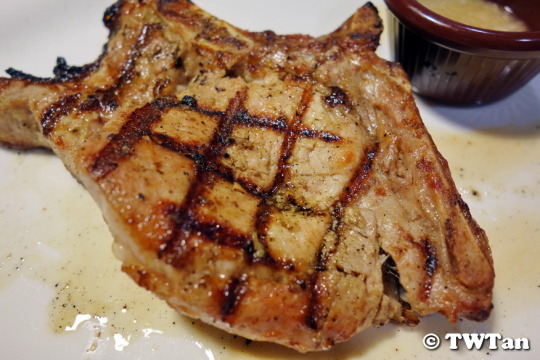
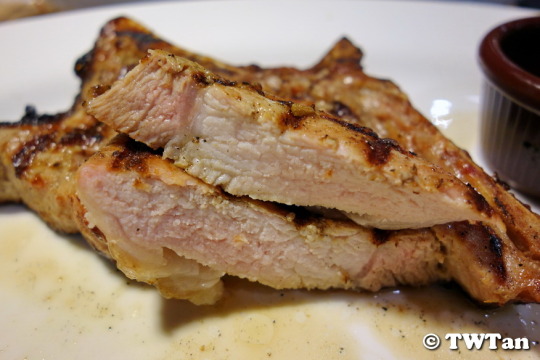
#Astons Specialities#Sembawang Shopping Centre#Restaurant#Western#Crispy Fried Fish#Tasty Rice#Onion Rings#Spanish Chestnut Pork#Pork Chop#Grilled#Charred#Apple Sauce#Coleslaw#Salad#Vegetables#Dinner#Food#Buffetlicious
19 notes
·
View notes